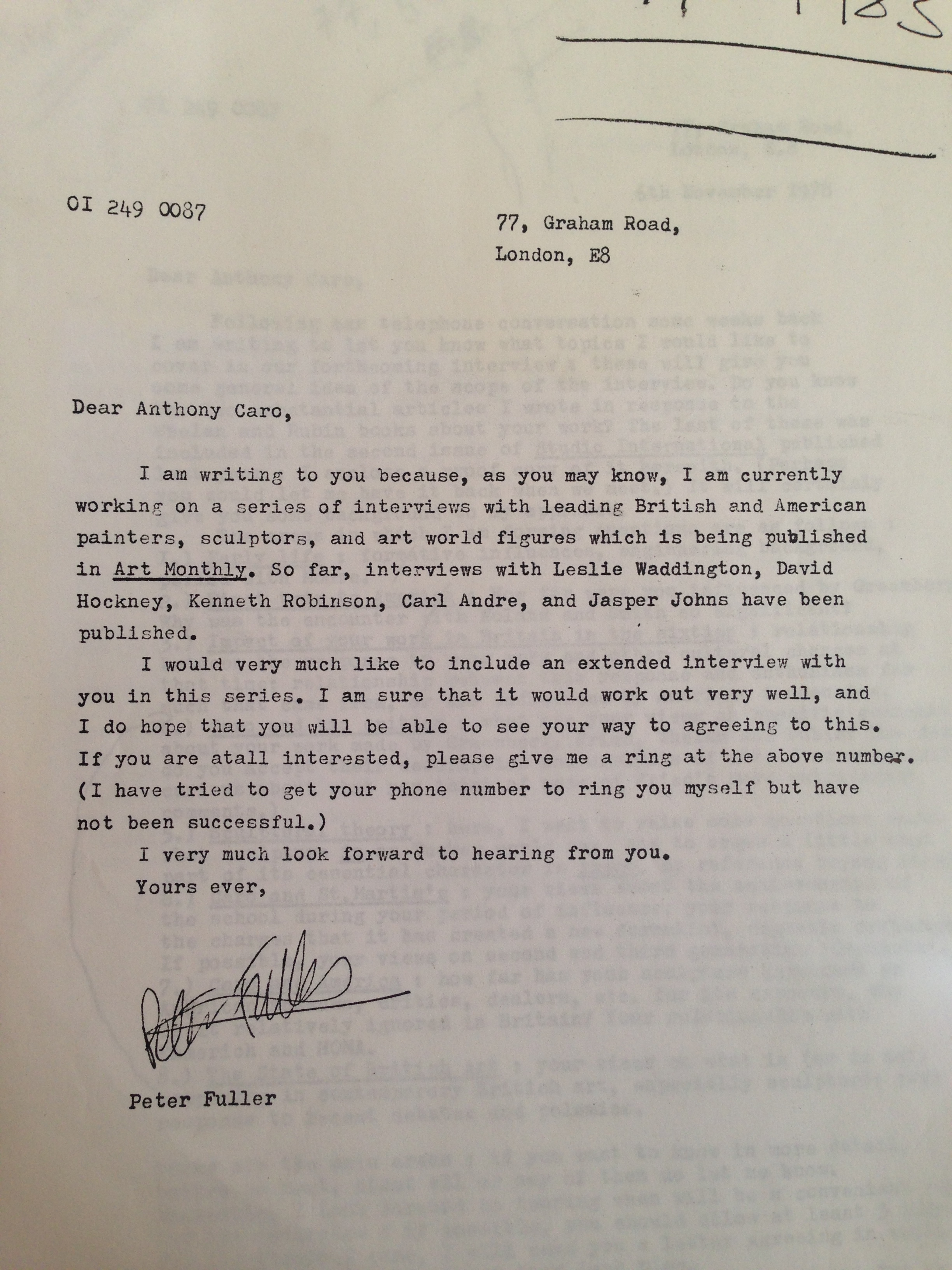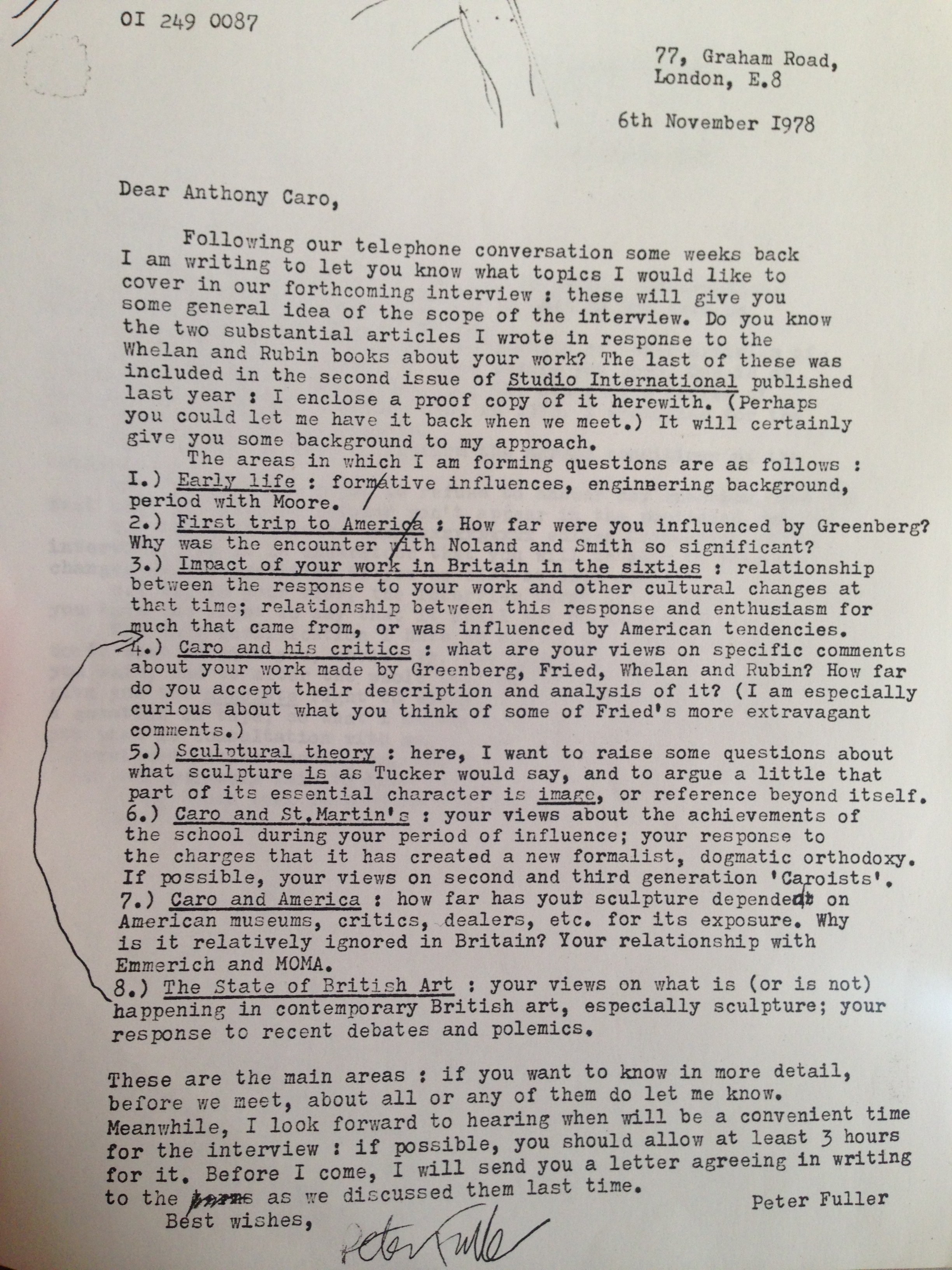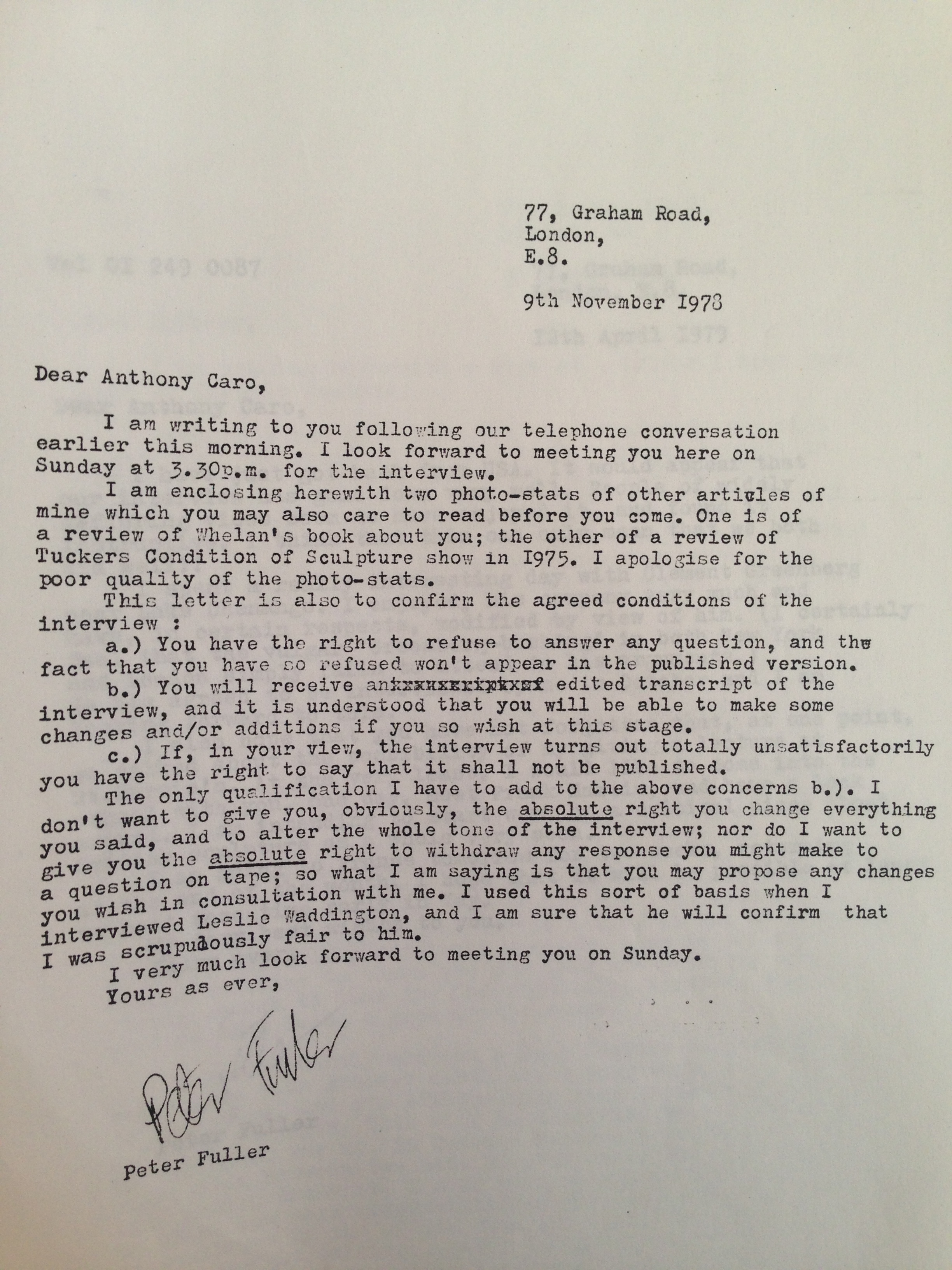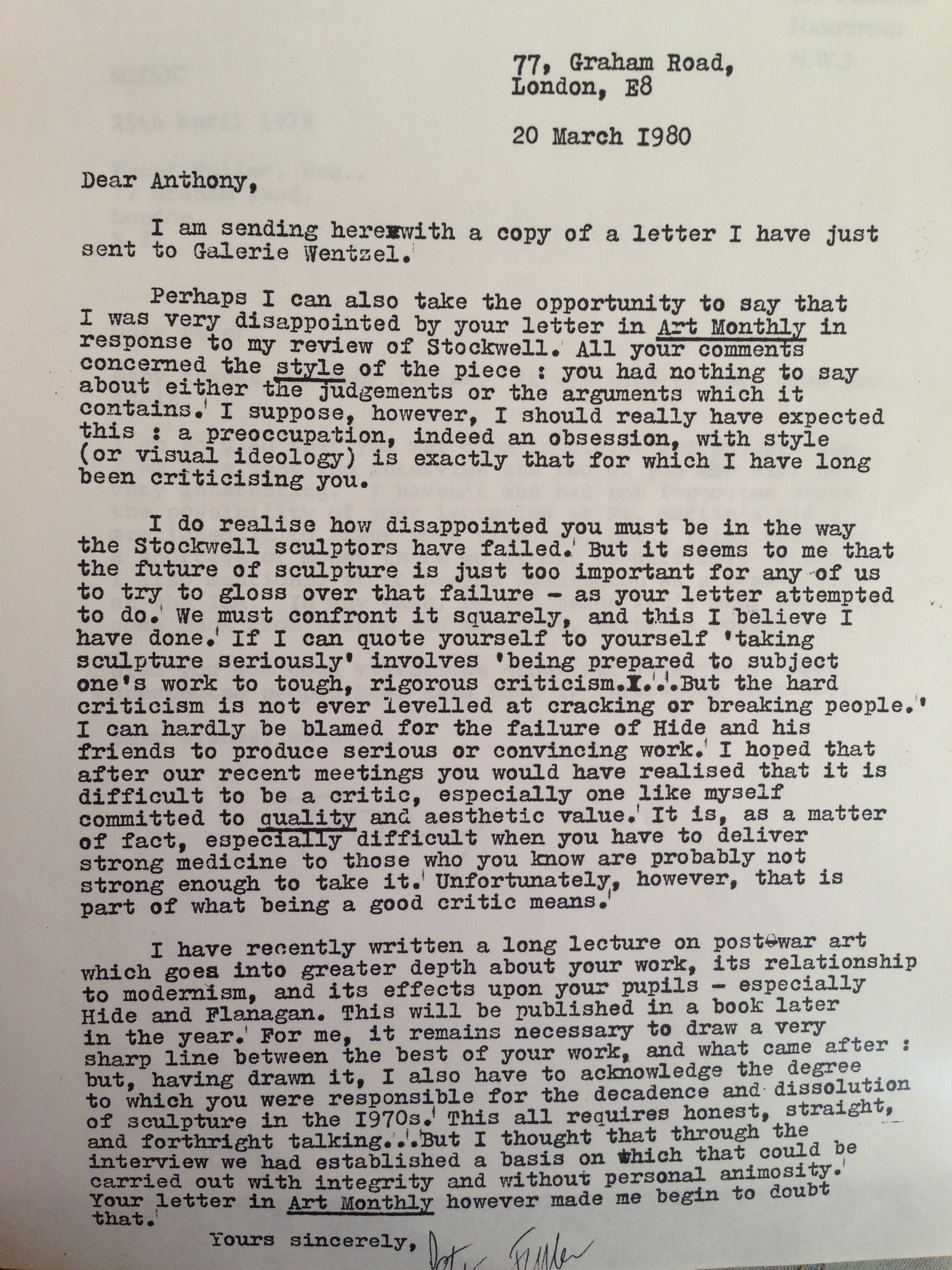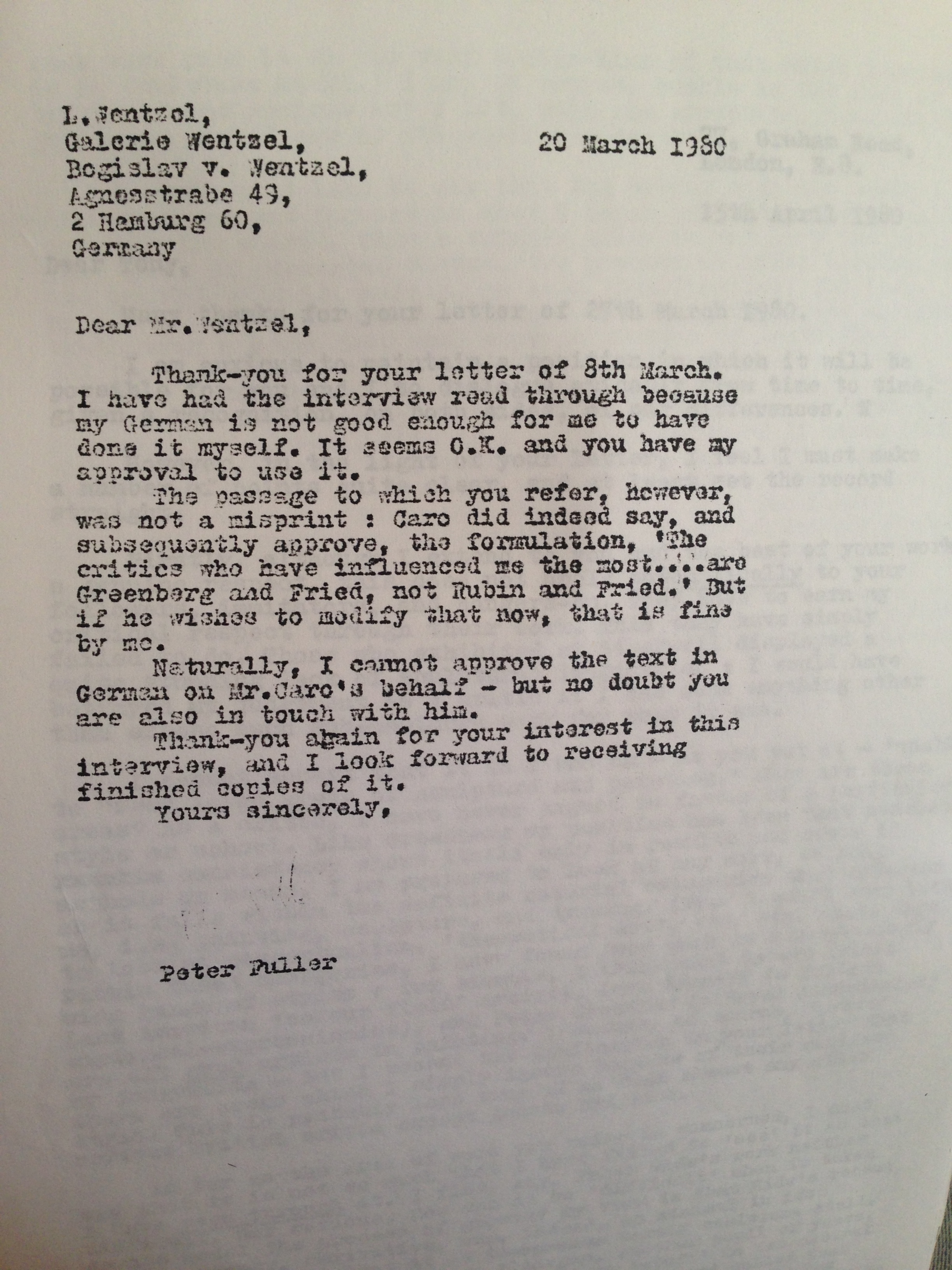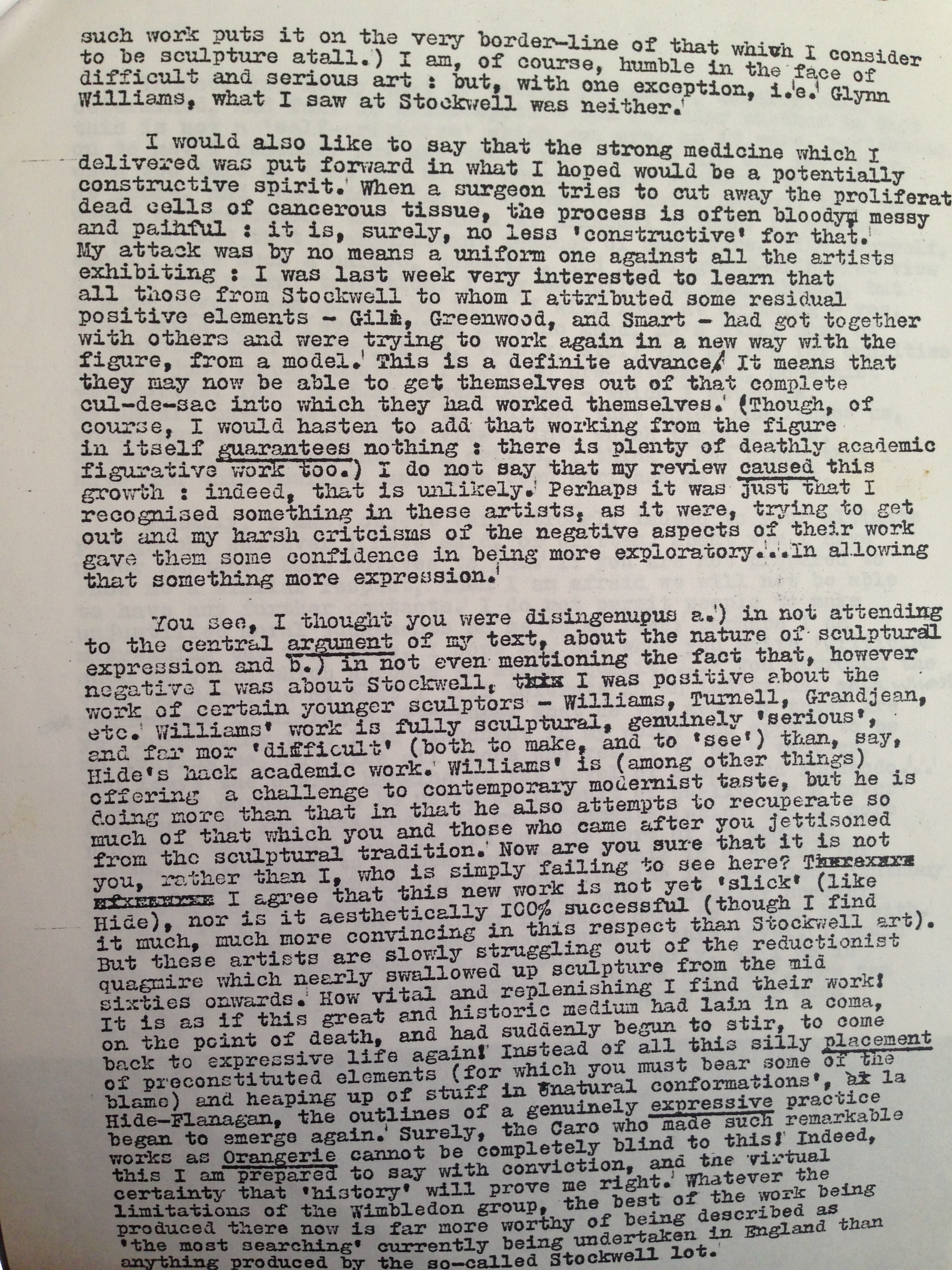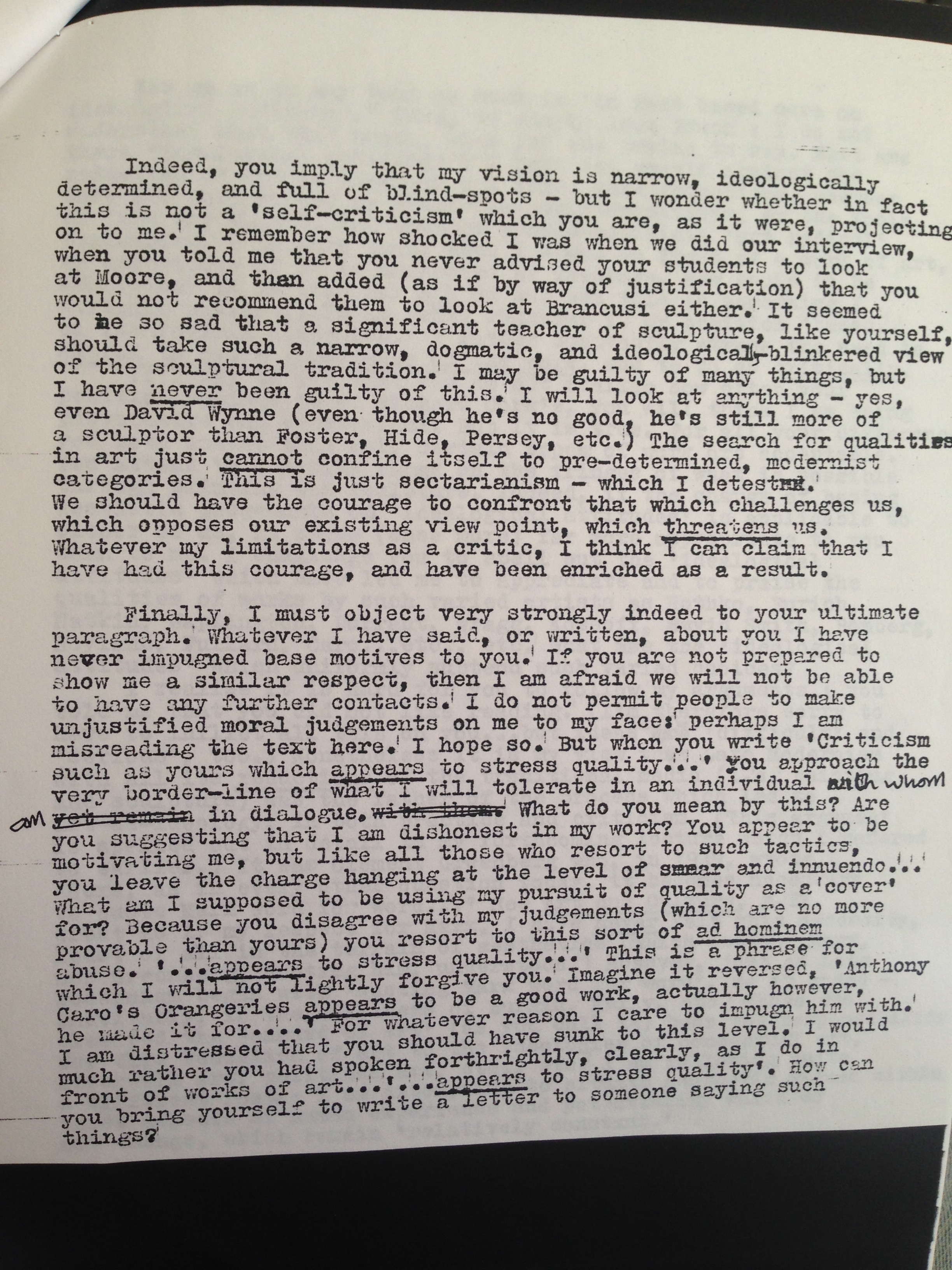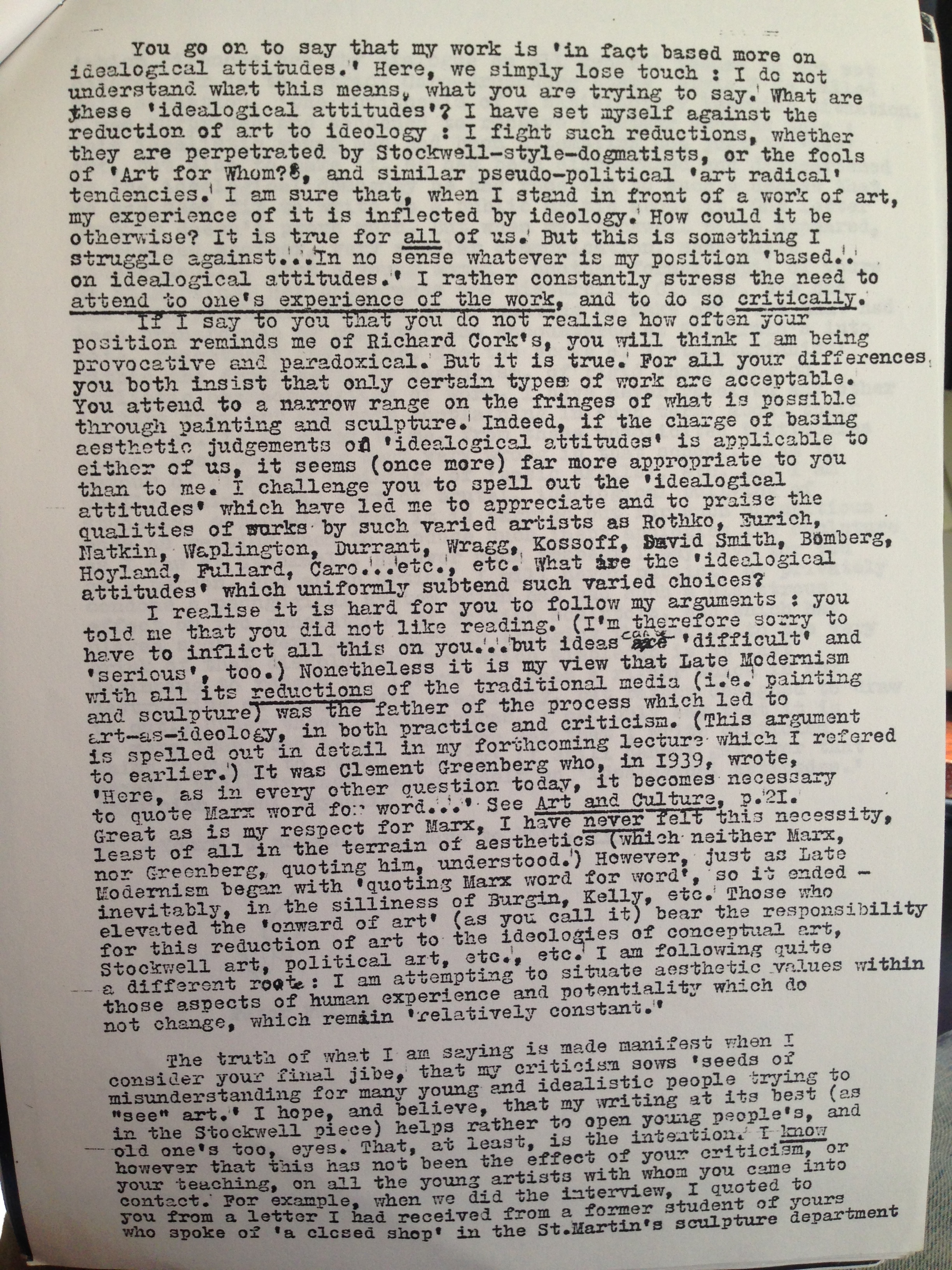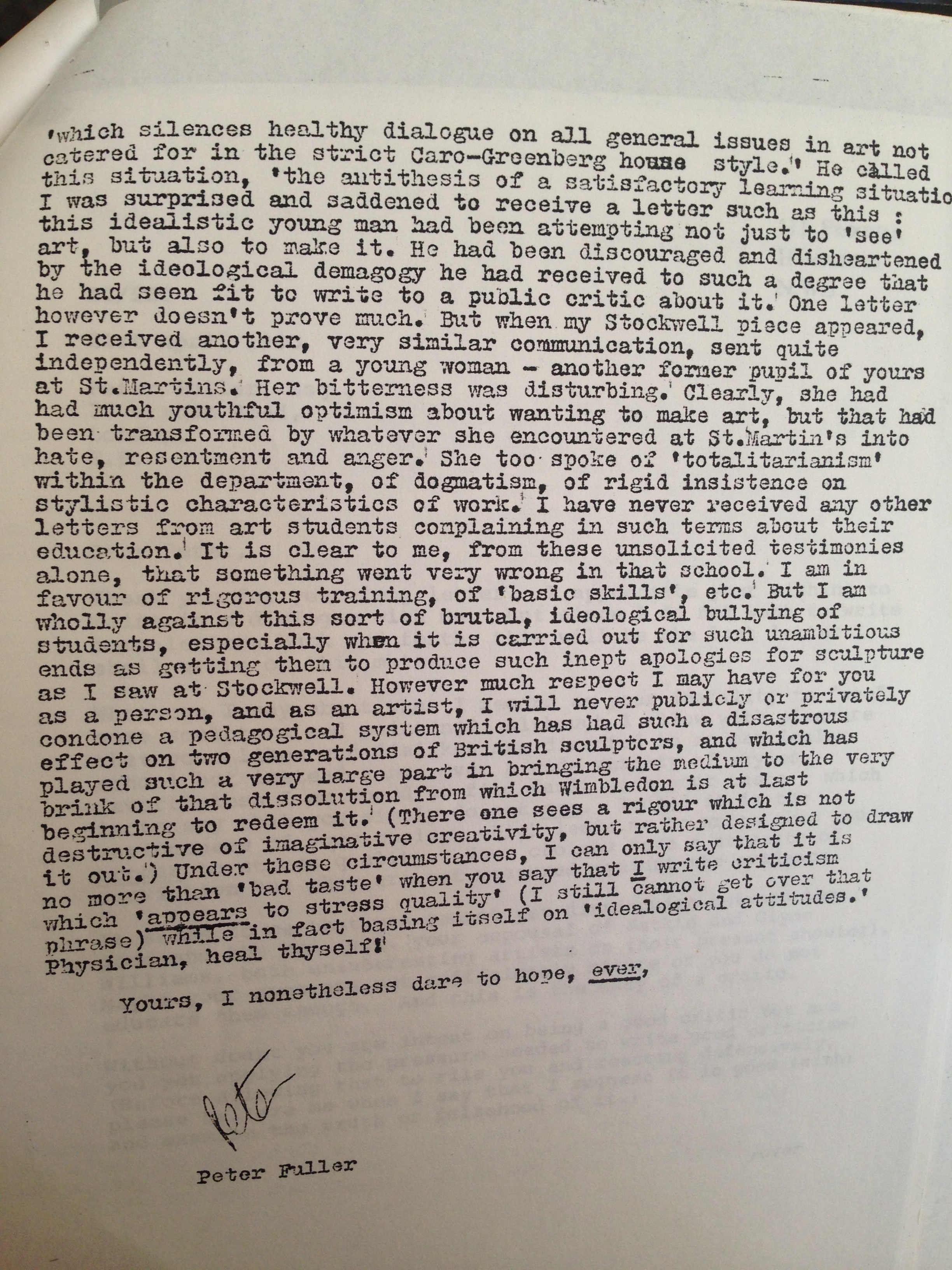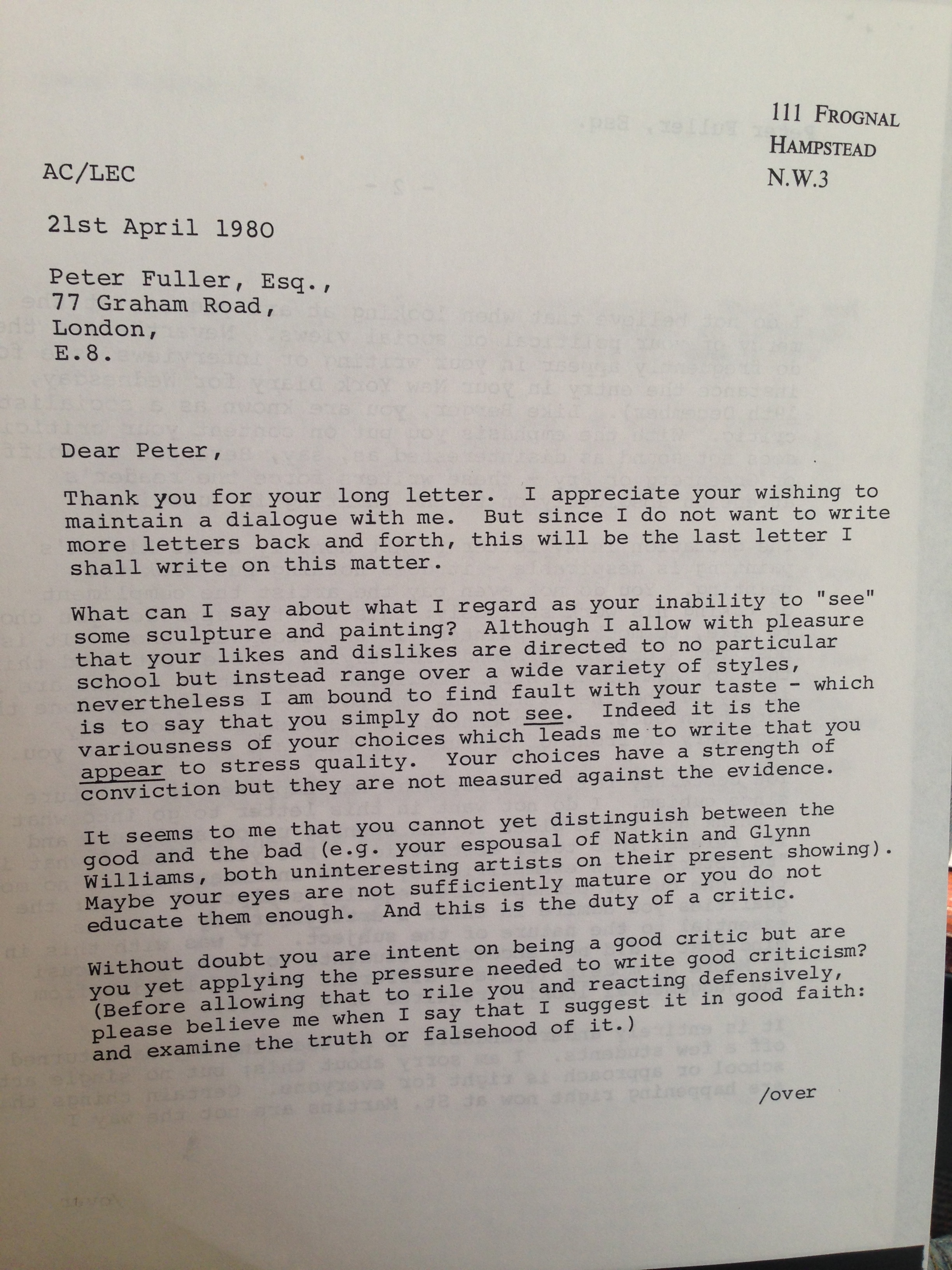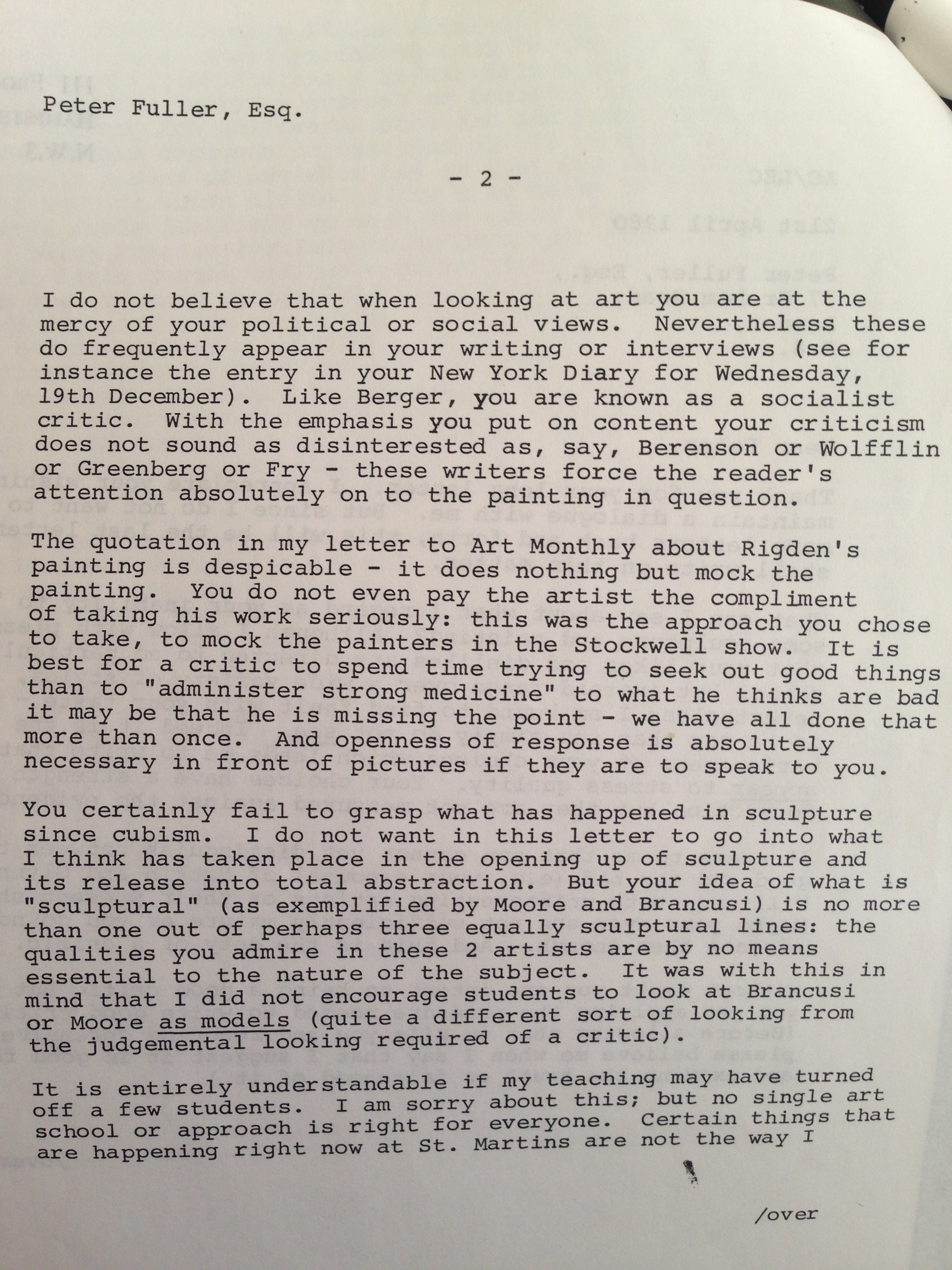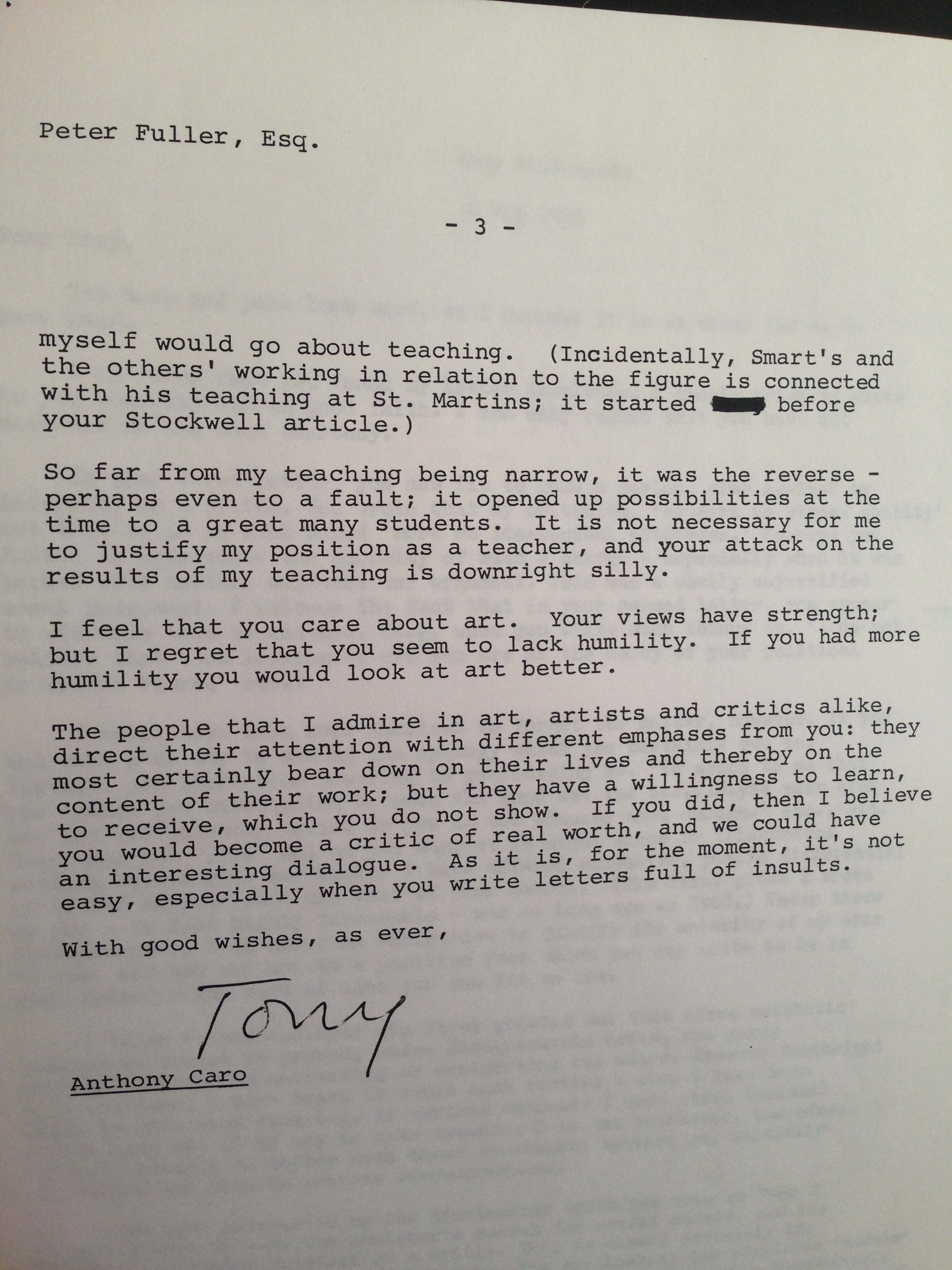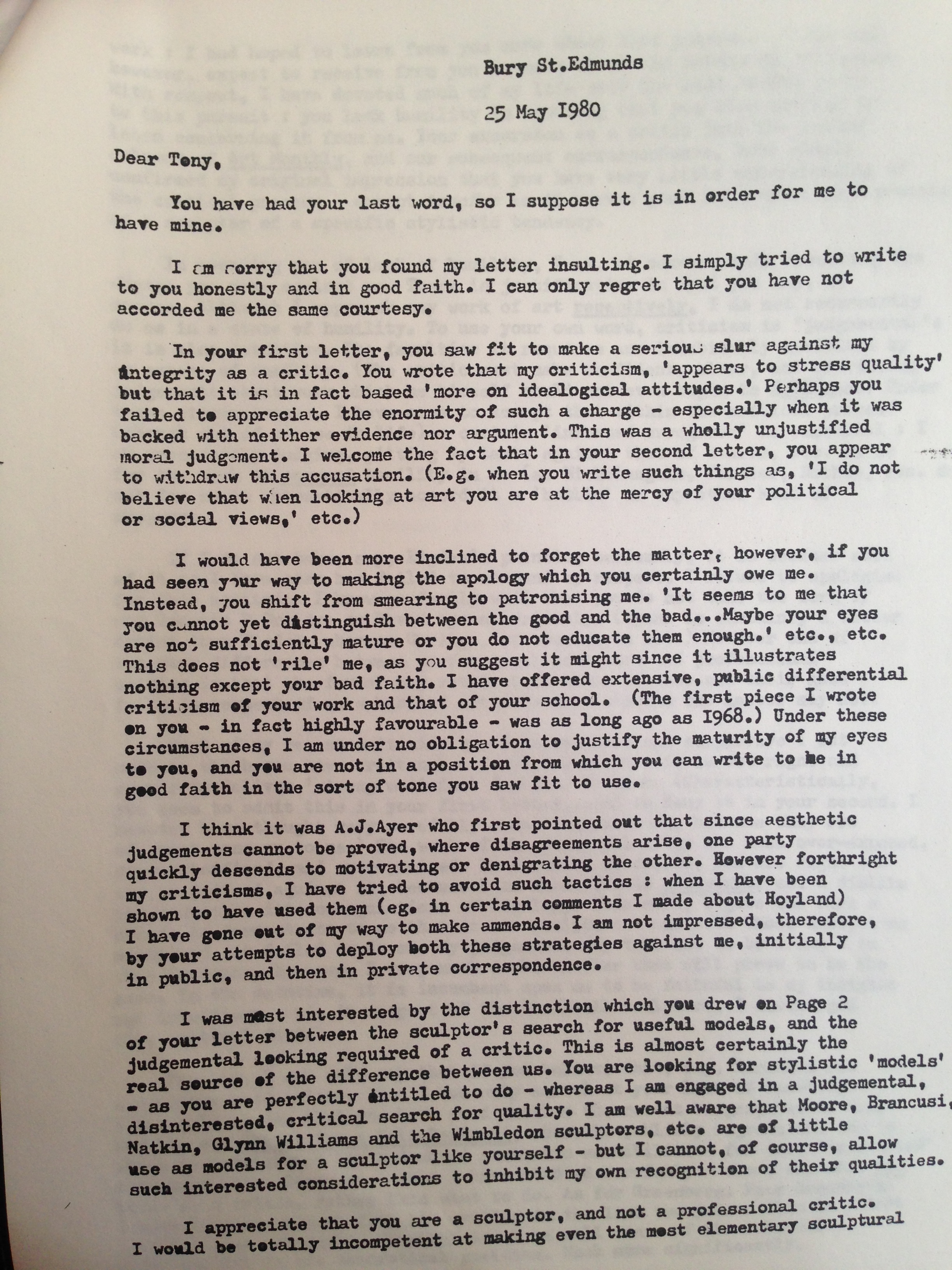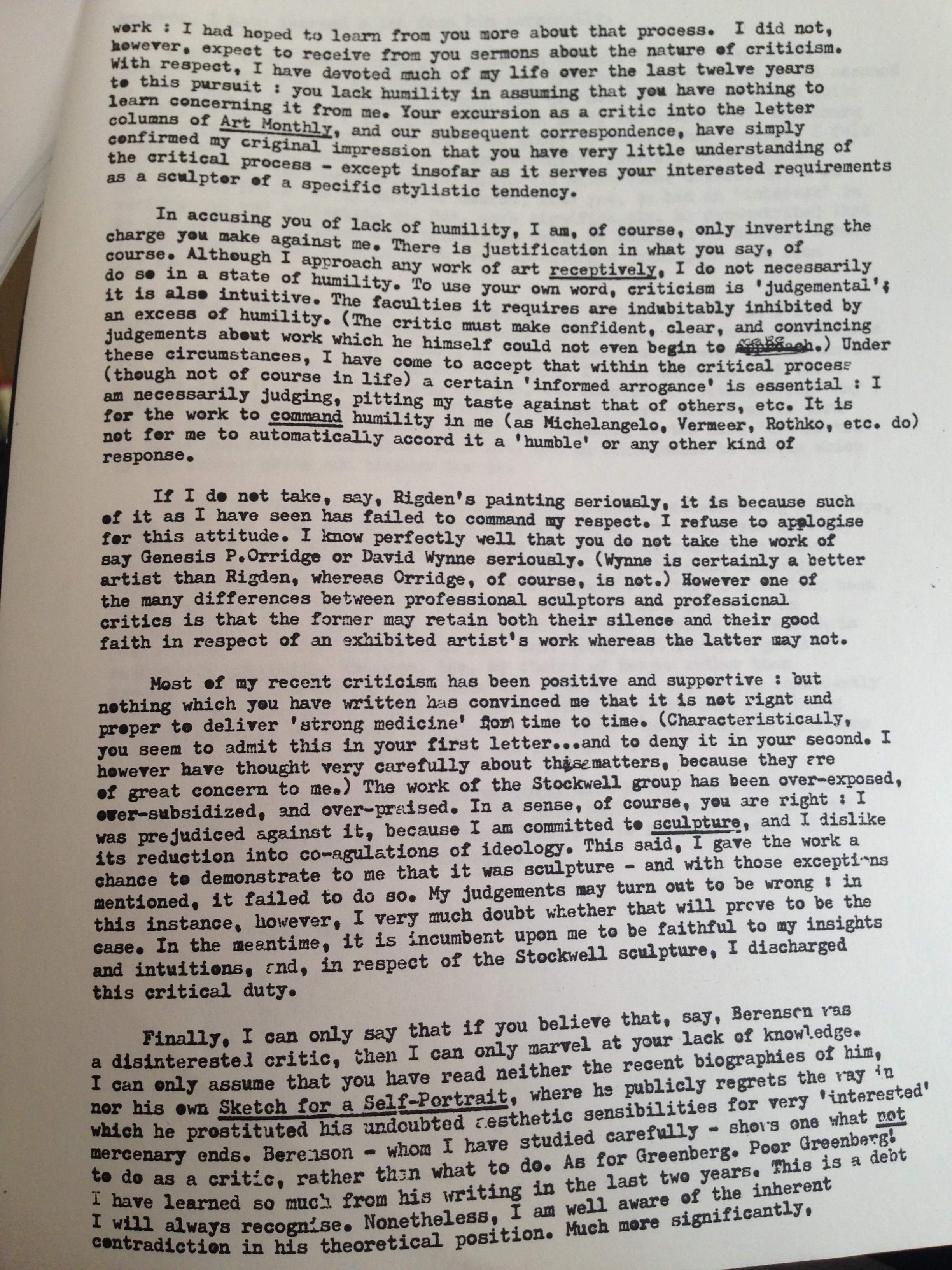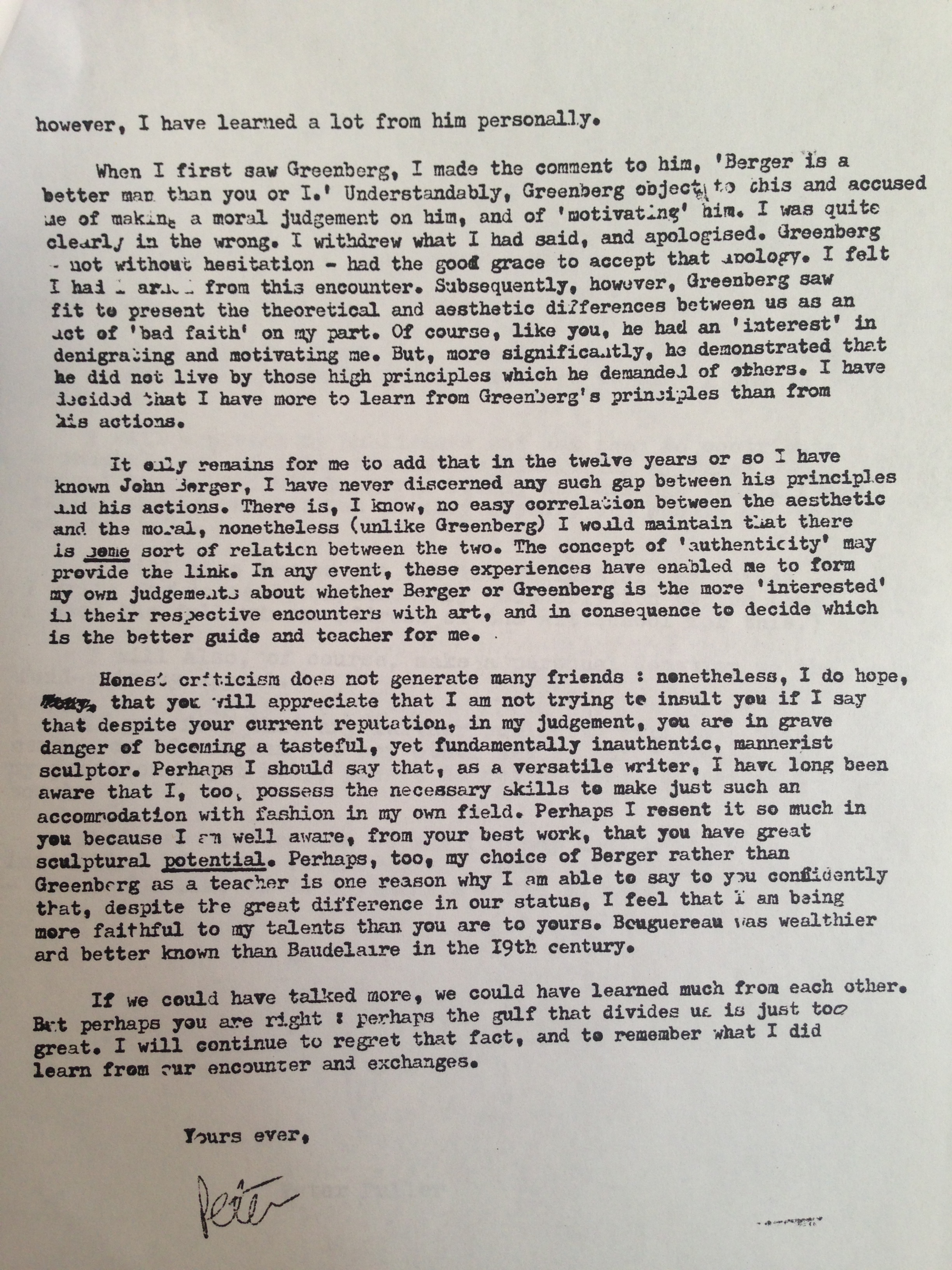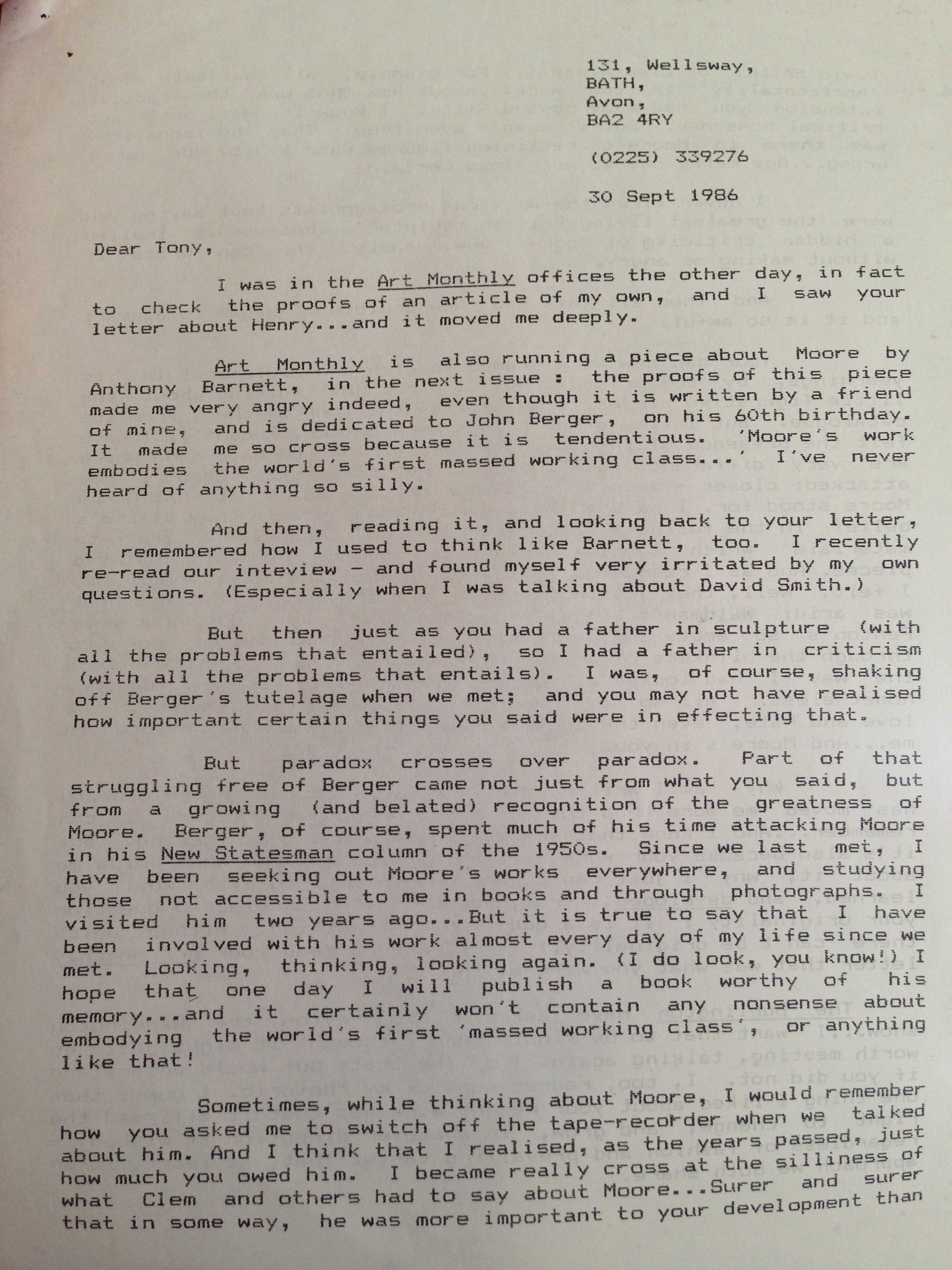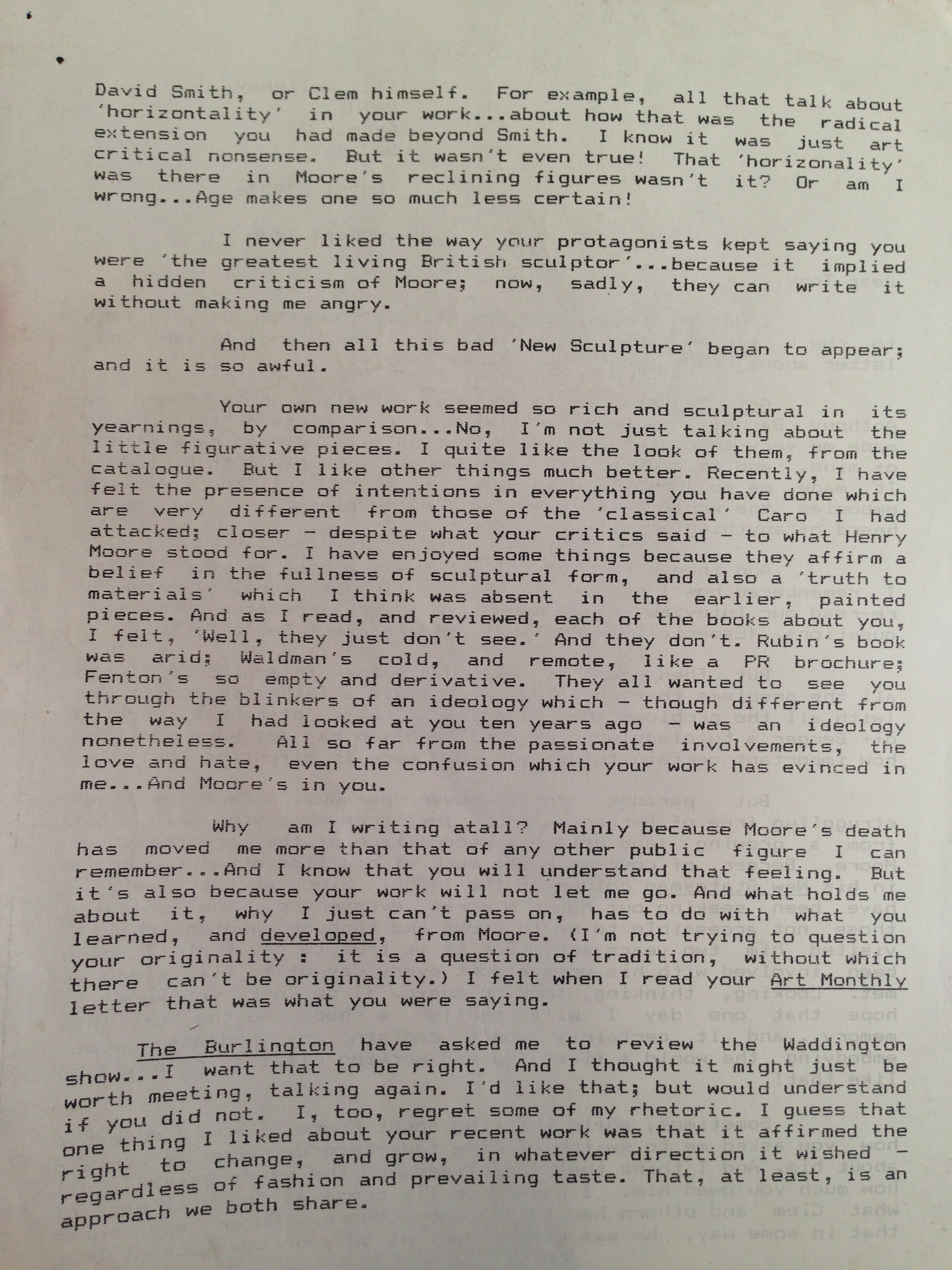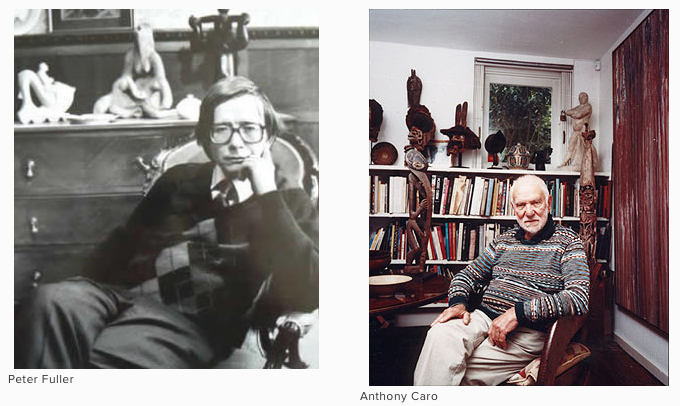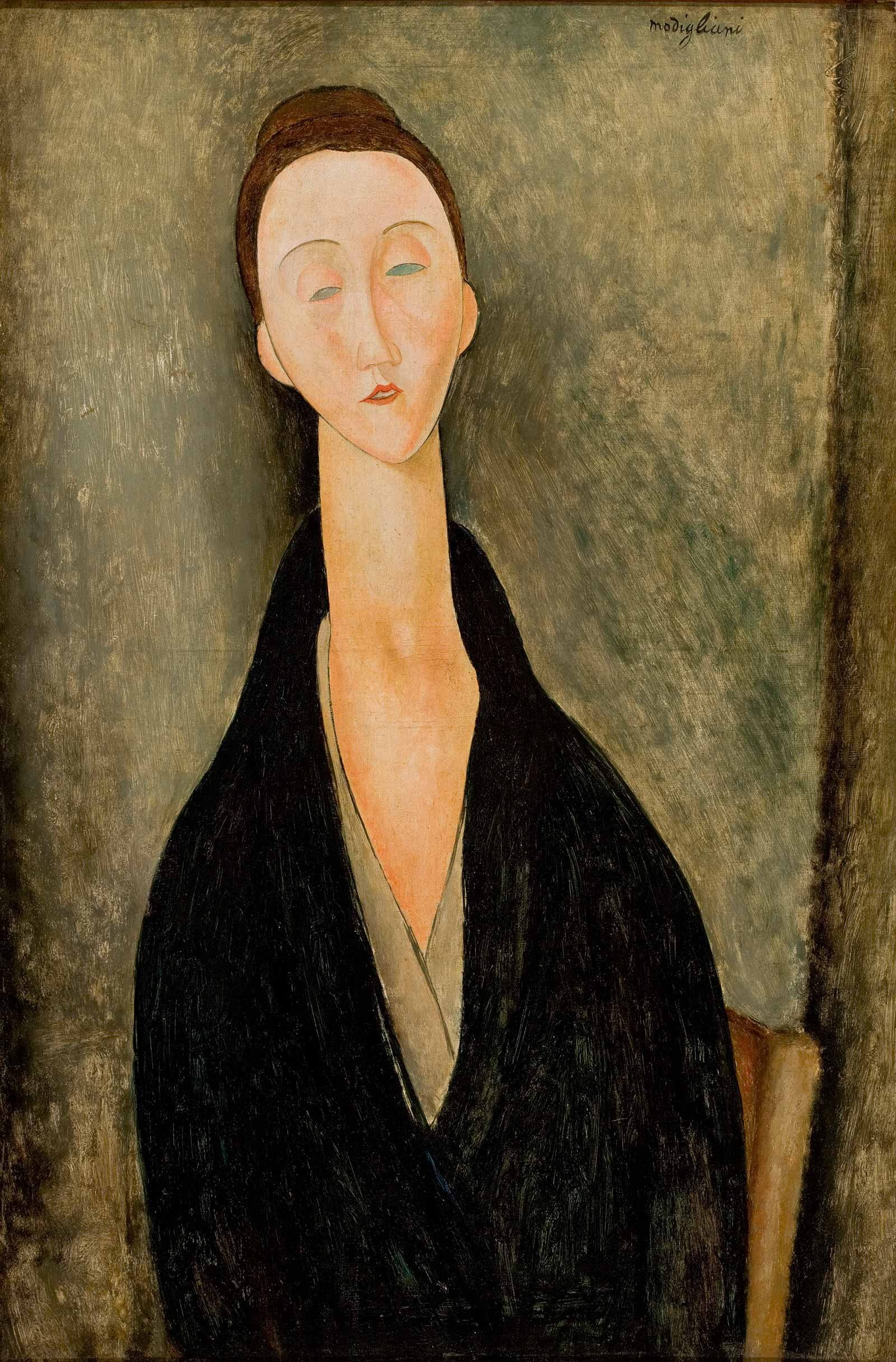Despite this, The Lady of Warka is not opaque to us. Her great age may give her an authority she did not have in her own time, but she is neither merely a document, nor a relic. Even after the passage of millenia upon millenia, this sculpture has the capacity to move us directly. More than that, I find myself able to formulate the judgement that of all the Sumerian sculptures which have survived that I know, this one is among the best, if not the best. The Lady of Warka manifests an extreme restraint and economy in its handling of planes and yet, at the same time, the delicacy and softness of the modelling, especially around the cheeks, mouth and chin, is such that the work seems expressive of pride, power, and sorrowful pessimism.
Not all Sumerian sculpture was as good as this. The Lady of Warka belongs to a brief sculptural efflorescence which seems to have sprung up on the threshold of the founding of the great Sumerian dynasties. Of course, she did not emerge from nowhere. The style — including that planar restraint — is characteristic of that which can be seen in animal amulets of the period. But not only is The Lady of Warka superior to almost everything surviving from its own time: nothing comparable has survived from several centuries afterwards. The Lady of Warka is of such quality that we can still recognize it as good when set beside sculpture of any age.
But what am I doing when I look back through aeons of time into a marble face from a civilization than which none is more distant from our own and pronounce, ‘This is good.’ How is it possible that this remote work can move me and communicate actively to me? For bourgeois art historians this is hardly a problem. For example, Andre Parrot happily chirps that ‘despite mutilation’ ‘this mysterious, impenetrable face still remains the perfect synthesis of “eternal Woman”.’ He continues:
She is truly Eve, a Mesopotamian Eve, with lips closed but seeming to express a melancholy disenchantment, a certain disdain towards life — life which is never really fulfilled, since pain and sadness far exceed the satisfaction and joy experienced by man. Such is the message conveyed by the Woman of Warka, which ranks among the greatest sculptures of all time and whose unknown author is worthy of place beside Michelangelo.
Now those of us who, according to the deathless prose of the conference prospectus, are working within ‘a definite field — that of a radical left intervention’, know just how to treat such writing on art. Parrot speaks of ‘Eternal Woman’. He even says, ‘Across the millenia, woman has never changed.’ Nonsense!. There are only specific women in specific historical circumstances, and what they are like is determined — in the last instance, of course — by the mode of production and the resultant social relations prevailing in the particular historical moment in which they live or lived. And as for ‘Man’ in general, that’s even worse — a piece of pure bourgeois ideology, sexist of course, and — unspeakable horror — humanist. And what’s all this about ‘pain and sadness’ inevitably exceeding ‘satisfaction and joy’? Subjective individualism! Doesn’t poor, bird-brained Parrot know that ‘pain and sadness’ are historically specific phenomena? When the mode of production is transformed and Communism realized, men and women will abolish ‘pain and sadness’ and live, presumably forever, in ‘satisfaction and joy’. Parrot is just projecting his petty bourgeois ideology on to an isolated fragment from an entirely different ‘signifying system’. After all, we know so little about the lost kingdoms of Sumer: men and women might never have experienced such things as ‘pain’ or ‘sadness’ there. They quite possibly lived for ever, too!
Fine. That’s the easy bit. Exit poor, bedraggled Parrot in a flap with his beak between his wings. But I look back into the face of The Lady of Warka and she moves me still. Do we, on the left, in our ‘definite field’ have a better explanation of the pleasure which I and others derive from this work, of the experience of it as ‘good’? Marx himself was at least aware that here was a problem. He wondered how, if the Greek arts were bound up — as they manifestly were — ‘with certain forms of social development’, they could still afford us artistic pleasure and even, as he saw it, ‘count as a norm and as an unattainable model’. (Marx primarily had literary works in mind: later, I will say more about the problems created by the direct transposition of literary models into discussions of visual aesthetics. Here, I merely wish to signal the difficulty.) But Marx’s explanation of the historical transcendence of works of art is hopelessly unconvincing. He argues that the charm of Greek art lies in the fact that it belongs to ‘the historic childhood of humanity, its most beautiful unfolding’, and that we find pleasure in it much as a man finds joy in the naivete of a child. Marx must have known that this just would not do: the argument survives only in an unpublished draft. Apart from the fact that Greek art is anything but manifestly naive, what Marx says is absurdly general. It does not allow for discrimination between the art of one ancient civilization and another, nor between works of the same civilization. Not all the art of the past seems to me equally good: it does not give me the same amount of pleasure. Am I to suppose that such differentiations are entirely explicable in terms of quantitative variations in the ‘naivety’ effect? The pleasure I derive from The Lady of Warka evidently cannot be wholly accounted for by some vague reference to the joy of what Mary Kelly might call the ‘Post-Partum’ period of human civilization.
There is a long legacy of attempts by Marxists to do better than Marx on this question without lapsing into Parrot-like ‘bourgeois universalism’. One argument insists that what makes a work historically transcendent is the vividness or ‘realism’ of its portrayal of the specific historical moment of its production. I hereby offer a hundred pound reward to anyone who can produce what I judge to be a credible account of The Lady of Warka in these terms! Reference to planar reductionism and the flat, fertile expanses of Sumerian agriculture are not likely to be accepted! What about this sculpture speaks of Sumerian society in 3000 B.C., or thereabouts, rather than any other historical moment, at any other time, in any other place?
There is, however, another line of reasoning which says that although Marx acknowledged that the production of art was historically ‘bound up with certain forms of social development’, he failed to see that so, too, was the consumption of art. Thus Marx did not see that modern admiration for Greek art owed less to some trans-historical essence in the works themselves than to aesthetic ideologies or philosophies prevailing in modern societies and their corresponding institutions.
I am prepared to go a long way with this argument: the high status enjoyed by, say, the Mona Lisa seems to me largely, though not quite entirely, institutionally or ideologically determined. But that residue which I reserve in the phrase ‘not quite’ seems to me much bigger, and of far greater importance, in many other works of art, including The Lady of Warka, which is hardly over-celebrated by art ideologists. I object to the contemporary ideology explanation when it is put forward as a total account, in part because it assumes that the rest of us — i.e. those who do not subscribe to the theory — are all such dumb-bunnies. We may think we are moved by such and such a work, that it has a powerful effect upon us, but oh no! that’s just an illusion: that is simply the prevailing ideology, excreted by contemporary cultural institutions, creeping into us.
I believe that by learning to look, and to see, one can — admittedly within certain limits — penetrate the veil of ideology in which the art of the past is immersed. The Mona Lisa may be a good painting or not; but because one emperor, once, had no clothes does not mean that all emperors, or empresses, everywhere and at all times are necessarily parading themselves naked. Indeed, the point of this excellent little story has always seemed to me to be that courageous, empirical fidelity to experience can, under certain circumstances at least, cut through ideology. Experience is not wholly determined by ideology: it is very often at odds with it, causing constant ruptures and fissures within the ideological ice-floes. And it seems to me that our experience of works of art, of any era, need be no exception to this if we learn to attend to the evidences of our eyes.
Let me give you another example. I often work in the British Museum Reading Room and, when I do so, I enjoy going to have a look at the Parthenon marbles at lunch-time. Now, evidently, these marbles have been torn out of their original physical, social, religious, political and ideological contexts. They have been shattered and eroded, wrenched from a position high on a Greek temple and stuck inside a (relatively) modern museum, where, since the beginning of the last century, they have been subjected to all sorts of imperial, nationalistic and other kinds of institutional and ideological hyping and cultural chauvinism. It would be simply foolish to pretend that all this did not mediate the experience of the works. Such mechanisms should be brought to light, analysed, discussed, and exposed: nonetheless, it is equally important to stress that they are not everything. We have no right to assume that the work itself only exists as a dissolved substance within its variable mediations, that it is inextricable from them.
Indeed, if you get to know the Parthenon frieze, you will begin to discover that some of the sculptors who worked on it were much better than others; you will be able to see this for yourself by using your eyes. Some were just not very good at expressing their experience of, say, doth in stone. They depicted folds in robes or drapery through rigid slots, dug into the marble like someone furrowing the surface of a cheese with a tea-spoon. Others worked their materials in such a way that their representations seem to have lightness, movement, and translucence: the stone breathes and floats for them. All the Parthenon craftsmen originally worked under identical ideological, social, and cultural conditions; the conditions under which their work is displayed in the British Museum may be very different, but they are nonetheless equally uniform. These differentials, however, remain, unaltered by the passage of time, and still discernible to attentive study of the work today.
Such distinctions are neither ‘merely technical’, nor trivial. They touch upon the difference between a good work, and a bad one, between a run-of-the-mill product of a particular tradition — which can be explained in terms of ideology and sociology — and a masterpiece, which cannot. John Berger, easily the best post-war art critic writing in English, recently made a self-criticism of his useful little book, Ways of Seeing. He wrote that ‘the immense theoretical weakness’ of that work was that he did not make clear what relation exists between what he calls ‘the exception’, or genius, and ‘the normative tradition’. This is a question which increasingly preoccupies me. The differences in quality of various sections of the Parthenon frieze can be intuited through empirical experience, through using our eyes: they are impervious to other kinds of analysis. I believe that the discernment of such differences is very much part of what is valuable in the pursuit and experience of art: they touch upon the point at which, in Ernst Fischer’s phrase, art makes manifest its capacity to protest against ideology.
But if neither of the principal groupings of Marxist explanations about pleasure in the art of the past stand up, must we return to Parrot and his bourgeois universalism? There is another way: one which involves the recognition of quality and aesthetic experience from within a materialist Marxist tradition. The great philosopher, Herbert Marcuse, was among those who struggled for this view: although I cannot accept all his aesthetic, let alone his political, formulations I have much more respect for him than for those neighing philistines inside the ‘post-structuralist’ corral who are intent upon submerging art into ideology and Consigning aesthetics to oblivion. Marcuse’s last essay, The Aesthetic Dimension, has recently been published in English. In it, he wrote: ‘Marxist aesthetics has yet to ask: What are the qualities of art which transcend the specific social content and form and give art universality?’ That is a question which, through the face of The Lady of Warka, I wish to keep in the forefront of a socialist concern with art. Marcuse has no inhibitions about saying that aesthetics must explain why Greek tragedy and the medieval epic — again his examples are primarily literary — can still be experienced as great or authentic (and for me that is the key word) today, even though they pertain to ancient slave society and feudalism respectively. ‘However correctly one has analysed a poem, play or novel in terms of its social content,’ he writes, ‘the questions as to whether the particular work is good, beautiful and true are still unanswered.’
Perhaps I should make one thing clear: I am not advocating that the social and ideological analysis of art should be abandoned as a futile pursuit. Far from it, I believe that an adequate map of the terrain, and also its economic and social determinants in terms of specific markets and publics for particular kinds of art-practice, is essential. If we do not have such a map how are we to know where ‘the good, true and beautiful’ may be lurking? Thus I readily acknowledge my indebtedness to my friends and colleagues, Andrew Brighton and Nicholas Pearson, whose excellent empirical research is showing us all just how inadequate was the map of contemporary art-practice with which we had been working. Just as a critic can rupture ideology by attending to his experience of the work, so, in the sphere of sociology (or history) of art the researcher can do so, in another way, by finding things out. Thus Brighton and Pearson are bringing our attention to vast tracts of art activity, and also of underlying art-market activity, which no one had bothered to investigate before. This sort of art research is very valuable indeed. There is another brand of so-called ‘left’ art history which, in the words of one of its practitioners, is so worried about not ‘sliding down the slippery unfenced slope of “the empiricism or the irrationality of that’s how it is and of chance” ’ that it never rises from its Polytechnic desk, or lifts its eyes beyond incestuously idealist ruminations about the nature of its own methodology, and its none-too-specific ‘interventions’. I would support Brighton and Pearson’s work over this sort of thing every time: nonetheless, I must insist, and I am sure they would agree, that the drawing up of the map may be a necessary prerequisite to the criticism of art, but it is not, in or of itself, identifiable with such criticism.
I will return to the nature of my critical practice and to the problem of identifying the material basis for aesthetic judgements; but first, I must be clear and explicit about the political position from which I am working. I therefore wish to make absolutely clear in what sense I am working within the Marxist tradition, and what sort of ‘Marxism’ I repudiate, indeed radically oppose myself to.
I want to talk in terms of excruciating simplicity: as I see it, Marx’s work emerged historically as a demand for justice for the oppressed, in particular for the proletariats in advanced, industrial countries. The early Marx had a vision which was in many respects idealist, utopian and humanist, of a form of society in which human potentialities could be fully realized. I am not interested in going back to that vision of the young Marx, retrieving it, and reviving its content as a diagram for the future: the now famous 1844 Manuscripts are a young man’s text, fragmented, disjointed, shot through with residues from Marx’s very early intellectual life and intimations of things he was to formulate more precisely, later on. There is much here that won’t stand up today. Nonetheless, I insist that the fact that Marx had such a felt, affective vision of what men and women could become, as against that which they were, tells us something essential about the nature of his project. Marx’s thought, at least as I understand it, developed continuously, with no ‘epistemological break’, out of his conviction that the world could be changed, that men and women could lead happier and more fully human lives in forms of social organization other than those under which they were living.
But Marx was no religious idealist: he knew that this better world had to be realized through the historical process, or not at all. With Engels, he thus developed a method, historical materialism, whose aim was the comprehension of that process in its totality. Marx envisaged that men and women would thus be enabled to act more effectively upon it, and through it, and might thereby succeed in changing it. But, paradoxically, the findings of historical materialism seemed to set limits upon the efficacy of even collective action: the determinative influence of the economy in every aspect of social life was exposed. In contrast to the classical economists, Marx described the historicity of the economy and demonstrated that, broadly speaking, changes in the mode of production produced profound changes in social, political and cultural life. Marx came to describe the economy as a base, or structure, upon which a superstructure was erected consisting of such elements as law, politics, philosophy, religion, art, etc., the specific ideological forms of which were determined by the base.
The base/super structure metaphor — and it was only a metaphor — was at once among the most illuminating of Marx’s insights, and among the most problematic of his formulations. The metaphor, as one might expect if Marx is even approximately right, owes much to the specific historical moment in which it was produced. It is permeated by a characteristically 19th-century mechanism and over-deter- minism. Yet, Marx was surely correct in emphasizing that the processes of physical production had hitherto possessed a causal primacy over other social activities and that, as it has been put, ‘they form a framework for all other practices which all other practices do not form for the economy in the same sense’. Now the elaboration of the exact relations between the economic, political, cultural and ideological orders was recognized as a problem even in the era of ‘classical’ Marxism. When it came to specifics, Marx himself was often contradictory. In one moment, for example, he recognized the ‘universal’ or trans-historical aspect of certain works of art; in another, he reduced art to an ‘ideological’ product of the base. Engels introduced certain significant qualifications into the theory, recognizing the ‘relative autonomy’ of components of the superstructure, and the determinacy of the economy only in the last instance.
Marx also described the division of society into classes whose differing economic interests necessarily led to conflict. But the composition of these classes was not naturally given:
the industrial proletariat, for example, made itself, but only under the conditions determined by a capitalist mode of production. In Marx’s view, the contradictions inherent within this mode of production would lead eventually to the intensification of the struggle between capital and labour, the resolution of which would bring about the establishment of socialism (i.e. the ownership of the means of production by those who produced the wealth) and eventually realize that vision with which he had set out, the idyll of communism.
Now Marx possessed one of the most astonishing intellects in history: it is possible to become almost drunk with the breadth, complexity and range of his thought. His intellectual achievement is without parallel. However, it is important to emphasize that Marx left behind, not a system, but a series of giant torsos of an argument which he never completed. Furthermore, as we might expect if he was in any way right, much of his work is permeated with 19th-century ideology. In particular, Marx possessed a teleology characteristic of so much 19th-century bourgeois thought: thus he had a vision of the better world of socialism, and he tended to argue as if what he once called the ‘inexorable laws’ of history were necessarily and inevitably working in that direction. Hence the notorious ‘prophetic’ element in Marxism. Furthermore, Marx often sought to legitimate the method of historical materialism by invoking and over-deploying parallels from the natural sciences — a practice which was to lead to disastrous pseudo-scientific schematizations of his thought among some of his followers. In fact, many of Marx’s predictions and analyses were quite wrong. For example, his political scenario for the immediate future had as its lynch-pin the immiseration of the proletariat in advanced industrial countries: this did not happen. Furthermore, in no such countries anywhere in the world have the working-class revolutions which Marx so confidently envisaged taken place. Monopoly capitalism developed new forms of a far greater resilience than would have seemed possible to Marx. Meanwhile, bourgeois economists developed techniques which, when applied by politicians, could at least delay and submerge the manifestation of the critical inherent contradictions within the capitalist system.
Even more problematically, in those predominantly peasant societies in which socialist revolutions did take place, they did not lead to those great advances in human happiness which classical Marxism might have led one to expect. Socialism improbably arose out of the ashes of Czarist Russia; but with it came not so much the dawn of an era of human freedom, as the implementation of a new and vigorous brand of tyrannous oppression and repression. I do not wish ritually to rehearse again here all the horrors of the Soviet State, the lies, systematic perversion of the truth, the gulags, mass murders, concentration camps, the repressive State and Party apparatuses, the secret police, the savage destruction of the peasantry, and the suppression of every impetus towards a ‘fully human condition’. To call all this ‘Stalinism’ is just too easy: it implies — a view Marx would have rejected immediately, of course — that somehow all that was one man’s fault. The point I am making is that the phenomenon we call ‘Stalinism’ is, even today, the central problem for all of us working within the Marxist tradition; even those of us who, like myself, entered that tradition after those successive waves of disillusionment, up to and including 1956, which accompanied the realization of the true character of the Soviet State. Stalinism is not something we can deftly define out of socialism by saying that it does not concern us because we want ‘the real thing’. Marx wanted that, too: but the point is that when the economic base was transformed in Russia, capitalism and feudalism were destroyed, and socialism implemented — there can be no fudging this through talk about ‘State Capitalism’ — the ‘real thing’ diverged hopelessly from the vision.
Why then, if that is what I think, do I insist upon situating myself within the Marxist tradition? The answer is that I am still committed to a this-worldly struggle for justice for the oppressed, who include, but who are by no means synonymous with, the industrial proletariat. I further consider that ‘Man’, by which I mean men and women as a species, possesses potentialities for social reciprocity which cannot be fully realized under existing social structures, and that it is possible to envisage the realization through the historical process of forms of society in which those potentialities would be more completely fulfilled. I thus share with Marx an insistence upon the need for a theoretical method which attempts to grasp the historical process in the totality of its complex actuality and becoming. Historical materialism seems to me the only method we have which can begin to do this. Its past failures, however, have cautioned me against those who would make of this method, or any purportedly derived from it, a way of getting at absolute, ‘scientific’ truth — or of achieving that ‘total’ view to which it aspires. Further, despite certain questions and reservations, I consider that Marx’s assignment of a primary determinative power to the economy, and his account of the division of society into conflicting classes whose contradictions will demand resolution in history, are basically right. For all these reasons, combined with my unwavering respect for Marx’s formidable intellectual achievement, his open-mindedness, and empirical insights, I consider myself to be practising within the Marxist tradition.
This said, I must quickly add that in my view that tradition in the West has been fractured, even fragmented, by the prism of Stalinism. There is no way in which one can, in good faith, look back upon the texts, theories, and historical and political analyses of Marx, from our present historical moment, and simply pretend that Stalinism is not an issue. There have, however, been a range of responses, some in good faith, and some not; some compatible with one other, others not. Divested of any tranquil confidence in the inevitability and blissful consequences of the achievement of socialism, Marxists in the West now occupy a wide range of world views which lead them into varieties of political alliance throughout the spectrum of the left.
In sharp contrast to what has been, over the last ten years at least, a dominant tendency in the Marxism of many Western intellectuals, I have found myself forming the view that a central flaw within classical Marxism was its lack of any adequate conception of man’s relationship to nature, indeed of man, not as an ideological entity, but as a specific species, limited by a relatively constant, underlying biological condition, dependent upon natural processes and a natural world which he cannot command. This focus emerged during and immediately after a prolonged therapeutic experience of psychoanalysis; a process which limits one’s sense of infantile omnipotence, of the magical changeability of all phenomena through the agency of one’s own wishes, exposes the inadequacies of the intellect on its own, puts one back in touch with affects, the concreteness of one’s own body, the bodies of others, and the reality of the external world. Psychoanalysis leads one to realize that there is more to life than what goes on in the head. These general shifts in orientation were given theoretical spine and muscle through my reading of a number of contemporary Marxist writers — including Perry Anderson, Raymond Williams, Edward Thompson, and, surprisingly perhaps, most significantly, Sebastiano Timpanaro. (I say surprisingly since, unlike myself, Timpanaro is no friend of psychoanalysis.)
Timpanaro constantly emphasizes that materialism must begin by affirming the ‘priority of nature over “mind”, or if you like, of the physical level over the biological level, and of the biological level over the socio-economic level.’ Marxism, however, was born as an affirmation of the decisive primacy of the socio-economic level over juridical, political and cultural phenomena, and as an affirmation of the historicity of the economy. It emerged as a methodology of human action; its ‘moment of becoming’ was, of course, that of the revolutions of 1848. But it thereby ran the risk of ‘evading or underestimating that which is passivity and external conditioning in the human condition’. That is why so many of those suffering from infantile omnipotence are attracted to Marxism. Although Marx himself did not ignore or deny physical and biological nature, for him, it constituted ‘more a prehistoric antecedent to human history than a reality which still limits and conditions man.’ With Labriola, Timpanaro is thus led to insist that ‘our dependence on nature, however diminished since prehistoric times, persists amidst our social life’. Thus he writes:
It is certainly true that the development of society changes men’s ways of feeling pain, pleasure and other elementary psycho-physical reactions, and that there is hardly anything that is ‘purely natural’ left in contemporary man, that has not been enriched and remoulded by the social and cultural environment. But the general aspects of the ‘human condition’ still remain, and the specific characteristics introduced into it by the various forms of associated life have not been such as to overthrow them completely. To maintain that, since the ‘biological’ is always presented to us as mediated by the ‘social’, the ‘biological’ is nothing and the ‘social’ is everything, would once again be idealist sophistry.
Timpanaro’s position is not ‘humanist’: he recognizes the validity of polemic against ‘man in general’, in so far as that concept is used to assert the naturalness of such things as private property, or class divisions. But Timpanaro stresses that man as a biological being, endowed with a certain (not unlimited) adaptability to his external environment, and with certain impulses towards activity and the pursuit of happiness, subject to old age and death, is not an abstract, or ‘ideological’ construction, nor yet a sort of superseded, prehistoric ancestor to social man, ‘but still exists in each of us and in all probability will still exist in the future’. Certainly, Timpanaro would never speak of ‘Eternal Man’, or ‘Eternal Woman’. Not only does he stress that the species, like any other, is subject to biological evolution, but he draws attention to the probable eventual extinction of the species itself and of the world which it inhabits. Nonetheless, he points out that certain significant aspects of the human condition appear to be very long-lasting indeed : these, as we shall see, are of great importance in any attempt to understand our capacity to derive pleasure from the art of the past.
For Timpanaro, while retaining Marx’s division into structure and super-structure, and re-affirming ‘the preponderant part played by the economic structure in determining the major transformations of juridical-political institutions, cultural milieux and forms of collective psychology’, is yet able to write ‘One cannot help but recognize also that there are non-superstructural elements in cultural activities and institutions.’ He goes on to say that this admission does not in any way undercut materialism but, as he puts it, ‘rather calls forth a closer consideration of that biological nature of man which Marxism, and particularly contemporary Marxism, tends to disregard’. The division structure/superstructure was, for Timpanaro, ‘a discovery of immense significance, both as a criterion for explaining social reality, and as a guide to transforming it’. It ‘becomes inadequate, however, when it is taken as an exhaustive classification of reality, as if there was nothing that existed which was not either structure or superstructure.’ Or, as he puts it, ‘It is not only the social relations between men, but also the relations between men and nature that give rise to scientific and philosophical reflection and to artistic expression.’ The point is thus not a revival of Feuerbachian ‘Man’, or of the ideological constructs of bourgeois humanism, it is rather the completion of the projects which they left incomplete: the elaboration, within the perspectives of historical materialism, of a materialist conception of man, and of his relations to nature; a conception which must begin by respecting the concrete achievements and real knowledge realized through the natural sciences — including physiology, psychology, ethology, biology, zoology, geology, physics, chemistry, and astronomy.
‘Man’ in this sense — I can only repeat — is not an abstraction, an ideological construct of the bourgeoisie that can be swept away in the attempt to supersede bourgeois modes of thought. After all, the bourgeoisie did not only begin the discovery of man, the extrication of him from false religious conceptions. As a class it was also the first to begin to acknowledge the specific developmental condition of childhood; to start to recognize the special needs of the child. There are, I know, a few poor souls who argue that therefore children, as such, are nought but the ideological constructs of the bourgeoisie and that ‘under socialism’ childhood will cease to exist once more. (It’s funny how those who argue like this so rarely have children themselves.) But what about spermatazoa? In an even more absolute sense than ‘man’ or ‘childhood’, the concept and the word ‘spermatazoa’ only enters the language with the bourgeoisie: the sperm was only discovered after the invention of the microscope, and became enmeshed in the mystical (or ideological) construct of homunculi. But does anyone really think no such things as spermatozoa existed before the bourgeoisie successfully identified them? Or really think that, with the achievement of socialism, we could abolish not just the concept, but the actuality of sperm, together with the rest of bourgeois ideology? That is exactly what certain ‘Marxists’ are asking us to believe in respect of ‘Man’.
To some of you, my emphasis on man as a biological being may seem like plugging the self-evident, a question of commonsense. But its very common-sense character is cited by one grouping within Marxism as ‘proof’ of the fact that it is mere ideology. I am referring to the Althusserians and their tendentious legacy of derivative factions and fellow-travellers.
‘Now that one cannot win anyone’s ear unless one translates the most commonplace things into structuralist language,’ writes Timpanaro, ‘the task of Marxists appears to have become one of proving that Marxism is the best of all possible structuralisms.’ Althusserianism, despite Althusser’s coquettish insistence that he merely flirted with the language of structuralism, is a structuralism. And, if there can be said to be any common perspective amongst the gamut of structuralists from Lacan to Levi-Strauss, from Foucault to Althusser, it lies in their resistance to the placing of ‘man’ as the origin of social practice, their onslaught against any idea of ‘man’. For Althusser, there is no such thing as the individual as such: ‘each mode of production produces its own mode of individuality in accordance with its specific character.’ What he has to offer is a profoundly antimaterialist, de-humanized, anti-historicist, anti-empiricist philosophical system which retains certain trappings of Marxist terminology.
It is not the fact that Althusser has revised Marx which worries me, although I believe many of his ‘readings’ of Marx’s texts have been carried out in bad faith; it is his end- product, which Edward Thompson, in his dazzling critique of Althusser, describes as ‘a sealed system within which concepts endlessly circulate, recognize and interrogate each other, and the intensity of its repetitious introversial life is mistaken for “science”.’ Meanwhile, Althusser’s theory banishes all human agency, and human subjects from the historical process, which, for Althusser, has no subject.
Far be it from me to initiate the uninitiated into this esoteric, academicist cult: it represents the inverse of everything which I find worth preserving in Marx’s work. According to Althusser, that vision of a transformed world which I characterized as essential to Marx’s project must be expunged from Marxism altogether: he speaks of the episte- mological break, an alleged sudden leap from ideology to ‘science’ within Marx, reputedly characterized by the rejection of humanism. Althusser goes on to paint a picture of the Mode of Production determining every aspect of the lives of men and women — in the last instance, of course — through the medium of ideology, which, in Althusser’s work, undergoes a mystical process of transubstantiation, thereby achieving material existence. ‘Human societies’, Althusser maintains, ‘secrete ideology as the very element and atmosphere indispensable to their historical respiration and life.’ But, for him, ideology is not just ‘false consciousness’: it is the ‘lived’ relation between men and their world. Now, if Althusser was merely saying that the knowledge men and women have of their world is always partial, continuously subject to development and modification, in which the material conditions of their lives play a great part, then I would heartily agree. However, he turns this partial knowledge, ‘ideology’, into an hypostasized — that is, a personalized — ‘transcendental subject, which, by interpellating individuals, constitutes them as subjects’. In other words, human subjects, men and women, appear not as ‘essences’, as in bourgeois humanism, the great heresy for an Althusserian, but as mere effects, or shadows of the great subject, out there, of ideology as secreted by the Mode of Production. In Althusser, it is not God who makes ‘man’ in his own image, but Ideology-and-the-Mode-of-Production, IMP which functions in his system exactly, but exactly, as if it were God.
In Althusser, all the essential qualities of men and women — the result of their specific biological conditions — are alienated from them, and attributed to the great IMP. We are all somehow immersed, dissolved even, into this allegedly material secretion of ideology, even if we don’t realize it. Empirical knowledge is, according to Althusser, worse than useless as a means of escape. Experience, for him, is but a manifestation of the effects of Ideology upon us. Only through the quasi-magical process of Theoretical Practice — which Thompson rightly sees as the rigor mortis of Marxism setting in, and which I would characterize as a sort of mystical communion of Ideology with itself, and not, of course, with the world — can one hope to rise above the ideological mire and achieve pure, transcendent, ‘Scientific’ truth. Thus — if Althusser was right the little boy on the edge of the crowd could never, ever, have seen that the emperor had no clothes; nor can you look out of the window and say, ‘It is a nice day’, until you have acted upon mere metereology with Theoretical Practice; nor, of course, can I look at those Parthenon frieze panels and say, ‘That one is good.’
No doubt I am lucky: I was inoculated, for life, against Althusser because I was brought up under the shadow of Karl Barth — the greatest theologian of the 20th century. (If you really must resort to this sort of system, then make for Barth, not Althusser. The breadth and scope of the twelve volumes of Barth’s Church Dogmatics is infinitely more subtle than Althusser’s tawdry texts.) So many of the arguments, however, are the same. Barth put God — Father, Son and Holy Ghost — as his hypostasized ‘Subject’ — who of course, also ‘interpellates’ us — where Althusser puts the great IMP. For Barth, too, God was wholly transcendent, unknowable, utterly Other, and as Althusser says of Ideology in General, without a history — i.e., the Subject, par excellence. Barth despises men and women, too: for him, they are immersed in sin, blindness, and delusion which they are unable to see, or see through, since it is their lived relation to the world, by the very fact of being men and women, born in original sin. Barth despises experience, hence his polemic with Brunner against Natural Theology — the belief that you can see the evidences of God, or ‘The Truth’ by scrutiny of Nature. For Barth, Redemption was only to be found by scrutiny of ‘The Word of God’, the Biblical texts, which he fetishized throughout his life, making judicious use of the new ‘scientific’ techniques of Form Criticism to establish the ‘correct’ readings. The systems, the arguments, and much of the methodology are pretty much the same. Althusserianism is a theology. It has nothing to do with materialism, and less to do with the struggle for material justice and equity in this world.
Christianity began as an eschatological movement; believers expected the end of the world, the Parousia, or Second Coming, and the establishment of the Kingdom of God in history. This did not happen. Pauline Christology was the ideological attempt to reconcile early Christians to their disappointment; to deflect their focus of attention from this- wordly history to heaven, through the medium of complex, abstract texts and concepts. The process was accompanied, inevitably, by institutionalization and the growth of a priestly caste, which became ever more remote from the popular roots of Christianity.
Engels, time and time again, compared the 19th-century socialist movement, in Europe, with primitive Christianity. Marxism emerged out of the popular expectation of history-transforming revolution, which did not come. Althusserianism is the Pauline Christology of Western Marxism. It is the attempt to reconcile revolutionaries to the indefinite delay of the Parousia in such a way that they do not lose the Faith. ‘The Truth’ this time, however, is to be found not so much in the monasteries and seminaries, as within the cloistered enclaves of academia. As Thompson puts it ‘Althusserian theory . . . allows the aspirant academic to engage in a harmless revolutionary psycho-drama, while at the same time pursuing a reputable and conventional intellectual career’ — or, I might add, artistic career, vide Burgin, Kelly, etc. It is, however, a total betrayal of historical materialism — to which I am committed.
Of course, like all religious groupings, Althusserianism has produced its splinter sects, many of which question Saint Louis Althusser’s total banishment of the human subject. Even the most psychotic among us sometimes get hints that we exist as a limited, physical organism, subject to birth, bodily existence and death. This faint glimmering perception of real people has led to a sort of gnostic carnival of Late Althusserianism — a sort of re-insertion into the argument of persons who are not really persons at all. This, of course, is where Lacan comes in. Lacan, blessed and sanctified by Saint Louis himself — in one of the latter’s most ignorant and preposterous essays — is a some-time psychoanalyst who has concocted a ‘radically anti-humanist’ subject, i.e. a sort of bodiless ghost, wholly ‘implicated in signifying practices’. Lacan’s subject is — in his own words: ‘. . . de-centred, constituted by a structure that has no “centre” either, except in the imaginary misrecognition of the “ego”, i.e. in the ideological formations in which it “recognizes” itself.’ You may think you were conceived in flesh and blood, and born of your mother’s womb; but in fact, you are a mere side-effect, literally, of IMP. In the last instance, of course. Lacan and his acolytes are as indifferent to the psycho-biological continuity of the species as Althusser himself. Thus Julia Kristeva trumps up a subject which ‘unlike the free or self-determining unified individual of humanist thought’ is nought but an over-determined, complex, ever-changing nexus of contradictions produced ‘by the action of social institutions and signifying practices’. Not a trace here of flesh, bones, perceptual organs, instincts, penises, wombs, vaginas, or stomachs. Just ‘signifying practices’!
Roger Scruton was correct in describing Lacan’s works as fictions, ‘rambling from theme to theme and from symbol to symbol with little connecting thread other than the all-pervasive “I” of paranoia’. Timpanaro has hinted at the way in which Althusser banishes the subject from the historical process to replace it with one subject, Louis Althusser himself (whose shadow, of course IMP is). Lacan’s later work is no more demanding of serious attention than, say, Ron Hubbard’s scientological dianetics or the writings of Helena Blavatsky. Lacan constructs the ‘self’ upon an infinitely labile model, which reproduces its elements, without constraint, like a language. He is entirely lacking in any materialist conception of men and women as physical organisms.
In Britain, however, there is an indigenous tradition of psycho-analysis — the so-called ‘object relations school’, extending from Suttie to Rycroft — which takes full cognizance of biological ‘Man’, as Timpanaro describes him.The theory of the Self in such writers as Bowlby and Winnicott — who significantly draw upon such disciplines as ethology and paediatrics, rather than structural linguistics — is infinitely superior, and infinitely less ‘ideological’ than that to be found in Lacan. It is a sign of the rabid idealism of the Left that their work is either not read at all or despised. Charles Rycroft, the most distinguished surviving representative of this school, has written, ‘the statement that psychoanalysis is a theory of meaning is incomplete and misleading unless one qualifies it by saying that it is a biological theory of meaning.’ Rycroft, rightly, goes on to say that psychoanalysis interprets human behaviour not in terms of entities external to it — such as IMP — but that it ‘regards the self as a psycho-biological entity which is always striving for self- realization and self-fulfilment’.
There are many Lacanian-Althusserians who forget that in order to become Heavy-Weight Champion of the World, it is not enough to be oppressed, or to ‘live’ the ideology of competitive capitalism. You also need to have big biceps and to lack large mammary glands. In many, many human endeavours constitutional elements, though never everything, are indubitably of decisive, determinative significance. Let me introduce a highly personal note. I suffer from a chronic rheumatic condition, ankylosing spondylitis, among the determinants of which is a genetic factor. The illness is 300 times more common in people who inherit a certain white cell blood group, HLA B27, than among those who do not. A side-effect of this can be sudden, painful inflammation of the irises of the eye. This has happened to me twice, the last time just a few weeks ago. It caused me to reflect not just upon the particularity of visual experience — of which more in a moment — but also upon the fatuousness, stupidity and insensitivity of those who argue that those elements of existence which are determined by ‘biology’ or nature, rather than ‘IMP’ or whatever, are trivial.
The elimination of the psycho-biological subject from Althusserian theory inevitably has inhuman implications. In their wrong-headed book, Language and Materialism: Developments in Semiology and the Theory of the Subject, Rosalind Coward and John Ellis write:
Reference to the notion of ‘subject’ creates the very problem of language this book is dealing with. Since the term refers both to an individual in sociality, and more generally, to the space necessitated by ideological meanings, we have chosen to designate the subject with the pronoun ‘it’.
There we have it! No more people, only things. Coward and Ellis are full of praise for the way in which Lacanian theory is ‘grounded in materialism’, because it denies ‘man’ and recognizes that ‘the conscious subject is constructed in a certain position in relation to the signifying chain.’ Thus we are told that the ‘ultimate effect’ of Lacan’s work is ‘a complete undermining of a unified and consistent subject, the assumption on which all bourgeois ideology is founded.’ And so, in this farcical world of topsy-turvy mysticism, the term materialism emerges as the exact inversion of its classical usage: it means here nothing more or less than the denial of the biological and physical levels, of the person as a physical entity, limited (and to a degree determined) by the finiteness of the body, the genetic constitution and the inevitability of death.
One practitioner who has fallen prey to this tendency recently endeavoured to argue with me that the pronoun T referred to nothing more than an ideological construct. An art historian who rants about signifying practices told me that, in her view, breast-feeding was unnecessary because ‘milk-filled plastic sacks’ were every bit as good. Naturally, if you deny any validity to the notion of the individual as a psycho-biological entity, you will end up saying such things. But I am not interested even in engaging with those who have such an idealist concept of the self. I turn, with relief, to the British object-relations tradition of psychoanalysis which begins with the recognition of the individual as an integral being, who, although he or she must immediately enter into social relations from the moment of birth in order to survive, possesses a physical separateness from, as well as a dependency upon, others. As Marcuse has noted, ‘Solidarity would be on weak grounds were it not rooted in the instinctual structure of individuals.’ Or, as I would want to put it, the continuing potential of the human species for socialism may have its remote biological, i.e. material roots, in the necessity of a relatively prolonged period of social dependency for the infant, if he or she is to survive.
The denial of the subject in Althusserian thought would be alternately pathetic and hilarious, were its implications not so serious. To cite Marx tells us nothing about the truth, or otherwise, of a concept. Nonetheless, it is worth pointing out to these Marxists that Marx and Engels never ditched the concept of ‘man’, least of all did they eliminate the idea of human agency. ‘It is men who make history on the basis of previous conditions.’ Or, as Sartre was to put it later, there is a space within which we can make something of that which has been made of us. The only words I would wish to add to Marx’s formulation are ‘and women’. But E.P. Thompson has drawn attention to the hysterical fury which Marx’s formulation evokes in Etienne Balibar, Althusser’s High Priest, and collaborator. Thus Balibar comments on the phrase, ‘the concept men . . . constitutes a real point where the utterance slips away towards the regions of philosophical or commonplace ideology.’ (Balibar wants to say that not just ‘man’, but also ‘men’, don’t really exist.) Balibar continues, ‘The “obviousness”, the “transparency” of the word “men” (here charged with carnal opacity) and its anodyne appearance are the most dangerous of the traps I am trying to avoid. I shall not be satisfied until I have . . . eliminated it as a foreign body.’
Carnal opacity! Let’s savour that phrase for a moment. Thompson points to its puritanism, its religious loathing of the flesh. Marx was absolutely correct to charge men with ‘carnal opacity’. We do, indeed exist with fleshly bodies, driven by hunger, and the vicissitudes and urgencies of the sexual instincts. (Why do Marxists always have so little to say about those, except on the eccentric fringes of the tradition.)
We exist, in feeling, fear, hope, greed and sensuality, and it is precisely that ‘carnal opacity’ of our material existence which the Althusserians want to wipe out. And as Thompson so rightly comments:
If we think about men as the trtiger (or mere bearers) of structures — or of their actions as ‘unjustified disturbance symptoms’ — then the thought will guide the act. As those lofty theoretical practitioners, the daleks, used to say, when confronted by ‘men’: ‘Exterminate!’
And this brings me back to the nature of Marxism and the centrality of Stalinism for all those who claim to be working within the Marxist tradition. For Thompson argues, in my view entirely convincingly, that although Althusserianism presents itself as anti-Stalinism, this is ‘a gigantic confidence trick’. For Althusser is only doing in theory what Stalin had already done in practice.
In the same moment that Stalinism emitted ‘humanist’ rhetoric, it occluded the human faculties as part of its necessary mode of respiration. Its very breath stank (and still stinks) of inhumanity, because it has found a way of regarding people as the bearers of structures. . . and history as a process without a subject ... It is only in our own time that Stalinism has been given its true, rigorous and totally coherent theoretical expression. This is the Althusserian orrery ... So far from being a ‘post Stalinist generation’, the Althusserians and those who share their premises and idealist modes, are working hard, every day, on the theoretical production-line of Stalinist ideology.
To some of you, this may all be academic. Stalin is, after all, firmly within his grave. But it is not just a question of theory, of attitudes to the past. In this decade, we have seen another successful socialist revolution — that in Cambodia — where, to use Balibar’s unhappy phrase — almost a third of a nation was ‘eliminated ... as a foreign body’. What happened in Cambodia was Absolute Stalinism, in practice. Thompson does not seem to me to be over-stepping the mark when he recalls, ‘with anxiety, that some of the leading cadres of the Khmer Rouge in Cambodia received their training in “Marxism” in Paris of the 1960s’.
Let me summarize all this: I am struggling for a position within the Marxist tradition which is humanist, in so far as it recognizes men and women as psycho-biological entities; utopian, in so far as it is rooted in the conviction that the world need not be the way it is, or the way it has been, and that men and women can live more happily than they do at present by ordering their social lives differently; empiricist, in that, within certain limits, it recognizes the validity of immediate experience; moralist, in that I consider certain refusals of infringements against the person to be absolutely right, and not just class interests in disguise, e.g. the refusal of torture; economist, in that I consider that, over a wide sphere of social and cultural life, given the qualifications I have already outlined, the economy possesses a determinative primacy; historicist, in that I affirm the validity, indeed the necessity, of the historical materialist recovery of the past; and aestheticist, in that I do not consider aesthetic responses to be merely emanations of bourgeois ideology. My position is not that of a wet, liberal refusal of theory: it is rather the result of my interrogation of history. I have engaged with these theories, and I am rejecting them — as I see it, in the name of the struggle for socialism. Nonetheless, every point in the position I have just outlined breaches a cardinal sin in the Althusserian breviary. Edward Thompson has declared that ‘Libertarian Communism and the socialist and Labour movement in general can have no business with theoretical practice except to expose it and to drive it out.’ I find myself in strong sympathy with this view, although not yet quite able to endorse it. I am still sentimental enough to cling until the eleventh hour to what is probably no more than a fantasy of unity.
I have raised certain questions about the Marxist approach to art; I have clarified my view of ideology and politics. I wish to end by making clear how all this affects my aesthetics and my critical practice. Let us return to The Lady of Warka. Certainly, what Parrot wrote about it was tinged with the ideology of bourgeois spiritual idealism. I admit that. But it was a more materialist account than any offered by Marxists who deny the psycho-biological continuity of civilized ‘Man’ altogether.
The Althusserian art-historian, Nicos Hadjinicolau, is forced to explain ‘aesthetic effect’ as ‘none other than the pleasure felt by the observer when he recognizes himself in a picture’s visual ideology’. Such a view of art, as Brighton has argued in his cogent critique of Hadjinicolau, excludes the viewer’s capacity to experience the work, and the work’s capacity to act upon him. The pleasure to be derived from art is reduced to a narcissistic mirroring process, in which all the work can do is to reflect back to the viewer some aspect of his historically specific illusions. But if ideology is as historically specific as the Althusserians suggest, it is hard to see what I could recognize in a work produced in Sumeria in the fourth millenia B.C. ‘Eternal Man’ may be an ideologically loaded construct; but, demystified, it points in the direction of a much more materialist account than that which we can derive from Althusser, Lacan, Kristeva, Derrida, Balibar, Hadjinicolau, Coward, Ellis, Tagg, Burgin, Griselda Pollock, Kelly, Screen Ed., or Tel Quel.
Marcuse, you will remember, claimed that the fact that a work truly represents the interests or the outlook of the proletariat or of the bourgeoisie does not yet make it an authentic work of art. Marcuse feels that the universality of art cannot be grounded in the world, or the world-outlook, of a particular class. Art, he says, envisions a ‘concrete, universal humanity, Menschlichkeit, which no particular class can incorporate, not even the proletariat’.This Menschlichkeit is, you might think, ‘Eternal Man’ transposed to a Marxist framework. Unlike the bourgeois aestheticians, Marcuse stresses not transcendence into the ethereal realms of spirituality, but ‘the metabolism between the human being and nature’, which, he says, ‘Marxist theory has the least justification to ignore’ or to denounce ‘as a regressive ideological conception’.
Marcuse’s view is reminiscent of the one I expressed earlier: not only the social relations between men, but also the relations between men and nature give rise to artistic expression. For example, as Timpanaro writes:
. . . love, the brevity and frailty of human existence, the contrast between the smallness and weakness of man and the infinity of the cosmos, are expressed in literary works in very different ways in various historically determinate societies, but still not in such different ways that all references to such constant experiences of the human condition as the sexual instinct, the debility produced by age (with its psychological repercussions), the fear of one’s own death and sorrow at the death of other’s, is lost.
But Raymond Williams takes us even further than this. He says:
... it is a fact about classical Marxism that it neglected to its great cost, not only the basic human physical conditions which Timpanaro emphasizes in his reconsideration of materialism, but also the emotional conditions which make up so large a part of all direct human relationship and practice.
In my view, these ‘relative constants’, deriving from man’s continuing embeddedness in nature, are of the greatest importance in the experience of many works of art.
Rothko once wrote that he was interested only in ‘expressing basic human emotions’. He added, ‘the fact that lots of people break down and cry when confronted with my pictures shows that I communicate with those basic human emotions.’ Predictably, Rothko is attacked in a recent article by two Marxist art-historians both for his allegedly ‘a- historical’ utterances, and for the ahistorical vacuousness of his pictures. But I think Rothko was right — in theory and practice. The reason his work transcends the shabby ideology and vacuity of American colour-field painting, whose socioeconomic determinants I have described elsewhere, is that, using these unpromising conventions, he does indeed reach through to significant aspects of the underlying ‘human condition’ by finding convincing representations for basic emotions. Similarly, Vermeer seems to have done much the same — although his painting refers not just to emotional life, but to certain ‘relative constants’ in the possibilities of human encounter with light, space and time. Again, Vermeer used the most ‘ideologically’ loaded of conventions — those determined by the Dutch, petit-bourgeois picture-market in genre painting. He was enmeshed within the ‘signifying practices’ of the class to which he belonged. Today, none of that matters very much to those of us who admire his great paintings. The point is that Vermeer ‘ruptures’ the ideology of his time, and of ours, by finding forms which speak vividly of potentialities inherent in those aspects of the life of ‘Man’, as a biological species, which do not change greatly from one socio-economic situation to another.
With both these artists, however, it is important to emphasize that the historically transcendent was not achieved by a denial of the culturally and historically specific, but rather by a working through of it. Here, too, we have an answer to an implicit problem for all Marxist criticism. As a theory of historical development, Marxism has always found it difficult to account for the fact that art is not subject to continuous or consistent development. The Lady of Warka is one of the oldest existing sculptures: it is also among the best. ‘Greatness’ and ‘quality’ in art must therefore derive from a relationship with aspects of human life which are, relatively speaking, very long-lasting indeed.
This is why Marcuse seems to me to be right when he says: A work of art is authentic or true not by virtue of its content (i.e. the ‘correct’ representation of social conditions) nor by its ‘pure’ form, but by the content having become form. . . Aesthetic form, autonomy, and truth are interrelated. Each is a socio-historical phenomenon, and each transcends the socio- historical arena.
If I understand him correctly, Marcuse’s defence of the autonomy of aesthetic form in the name of art’s own dimension of truth, protest and promise, does not imply a hermetic separation from exploration of the continuous potentialities of man’s underlying biological condition, but rather points towards an immersion in them as an implicit affirmation of the possibility of Menschlichkeit, as against the reality of a class-divided world. Or, as he puts it, ‘The autonomy of art contains the categorical imperative: “things must change”.’ Elsewhere, I too have spoken of the way in which great and authentic art, whatever its subject matter, constitutes a ‘moment of becoming’ which speaks of a possible historical future now.
Here, however, I wish to introduce what is perhaps the single most significant idea that I have learned from an Althusserian critic — namely Pierre Macherey. He argues that the aesthetic product is, like any other, the result of the application of a means of labour to transform a raw material. Unfortunately, because of his relativistic extremism, Macherey cannot usefully elaborate this concept. But Williams, recognizing the validity of biological ‘Man’ is able to do so. He writes:
The deepest significance of a relatively unchanging biological condition is probably to be found in some of the basic material processes of the making of art: in the significance of rhythms in music and dance and language or of shapes and colours in sculpture and painting . .. What matters here — and it is a very significant amendment of orthodox Marxist thinking about art — is that art work is itself, before everything, material process; and that, although differentially, the material process of the production of art includes certain biological processes, especially those relating to body movements and to the voice, which are not a mere substratum but are at times the most powerful elements of the work.
This passage is crucial. Most discussions of Marxist aesthetics take literature as their model: indeed, much of the sort of Althusserian left writing on art which I am attacking is a direct transposition of arguments about literature into the domain of the visual arts. However, I am maintaining that if we attend closely, in a materialist fashion, to the material practices of drawing, painting, and sculpture, we will discover that the arguments from literature are not valid for these practices, precisely because the biological processes (whose importance the Althusserian cannot admit) are much more important in them. It is not just that you do not have to study life-drawing or anatomy in order to become a good writer. A major difference between literary practice and drawing is that the word dog has a more opaque relationship to a dog than does a drawing of a dog. But the sculpture of The Lady of Warka is — to use Saint Louis’ own phrase about art — ‘bathed in ideology’ to nothing like the same degree as any work of literature, precisely because of its much deeper dependence, at the level of what it expresses and the way it expresses it, on relatively constant, underlying, biological elements of human life. Again, it is not just that in the entire history of sculpture, from the time of the Sumerians to that of Rodin, there has not been one significant work which is not either a representation of a man, a woman or an animal, whereas texts have been written on many varieties of purely abstract subject. It is also that in its material processes, sculpture is much, much more intimately linked to the biological and physical levels of existence than are, say, literature or philosophy.
Painting, of course, is in an intermediate position — somewhere between literature and sculpture; the significance of immediately biological processes and representations is greater than in the former, less than in the latter.
In my view, this recognition that the different arts are material processes in which the underlying biological processes are of varying significance casts quite a different light on the now all too familiar and often hysterical attack by Althusserians and structuralists on painting and sculpture as ‘bourgeois’ forms which must be smashed, superseded, destroyed, or otherwise annihilated. It was Burgin, I think, who dismissed painting as anachronistic daubing and smearing with coloured shit. But my point is that painting, drawing and sculpture, although they are always the bearers of ideological elements, and acquire significant aspects of their particular forms through socio-economic influences, are, as material practices, no more reducible to ideology than are childhood, spermatazoa, or, above all, ‘man’. The Althusser- ian-Structuralist mode of discourse on painting is about the ideological elements within painting, not about painting as such — as a material practice. We might well pause to ask why in all their multitudinous utterances upon art, Althusserians never speak of song or of dance. It is not just that the trans- historical character of these particular material practices — whatever their specific forms — is self-evident. (Who, after all, would want to march forward into a world where song and dance had been wiped out as ‘bourgeois’ art forms, except perhaps a few King Street die-hards?) But in these arts the material substance upon which the performer — or psycho- biological existent subject — works is that of his or her own bodily being; precisely that which, if you are an adherent of Althusserian theology, you wish to reduce to a mere ghost of no determinative significance.
Indeed, Marcuse has said that the rejection of the individual as a bourgeois concept recalls and presages certain fascist undertakings. The attack upon such material practices as drawing, painting and sculpture not only echoes those undertakings; it is also suspiciously reminiscent of that theoretical project to eliminate ‘Man’ as a psycho-biological entity, under the guise of an assault on bourgeois ideology, which characterizes Althusserian theory and Stalinist practice, and which I have already described at length. ‘This notion of theory,’ writes Thompson, ‘is like a blight that has settled on the mind. The empirical senses are occluded, the moral and aesthetic organs are repressed, the curiosity is sedated, all the “manifest” evidence of life or art is distrusted as “ideology”.’ Thus, inevitably, when those blighted by this theory or its derivatives turn to making works of art, they can themselves produce only art which is nothing but ideology.
In ‘Fine Art after Modernism’ I discussed in detail my conception of the historical growth of the Fine Art tradition and of the way in which it was shaped and contained by the institutional and professional structures of the bourgeoisie. I have talked about the development of a Mega-Visual tradition in the era of Monopoly Capitalism, and about the way in which this greatly changed the social function of the professional Fine Artist. I took the view, which has also been argued by Kristeller, and more eloquently by Raymond Williams, that the concept of ‘Art’ (with a capital ‘A’) as we use it today was historically specific, i.e. ideological. While that still seems to me to be true — and I unequivocally reaffirm it today — it is perhaps the case that I did not make it sufficiently dear in the past that the material processes of drawing, painting, and sculpture were not, in this respect, identifiable with ‘Art’. They have a material continuity which extends back into the earliest social formations. That continuity is now threatened by the encroachments of the Mega-Visual tradition. Indeed, E.P. Thompson draws attention to the way in which so much Althusserian idealism is not so much the inverse of bourgeois ideology, but rather an immediate reflection of its academic modes. Similarly, in the art world, the case against painting and sculpture is not unique to the left. What Victor Burgin advocates is also what Monopoly Capitalism is bringing about in reality. Burgin’s expressed hostility to ‘privileged’ media can be compared with the arguments of a specifically anti-Marxist sociologist, Robert Taylor; while his compositional devices are those of a Mega-Visual advertising man. Meanwhile, it is as well to remember that Burgin is not some outsider who has, as it were, been allowed into the extremities of the Fine Art garden-party by mistake. He is now at the very centre of the stage, deeply imbedded within the art institutions, prominently featured in two out of the three Hayward Annuals and in the Hayward photography show. He has held a succession of academic appointments and fellowships in visual arts schools. If there is any merit in his own argument, all this would not be possible unless the prevailing ideology favoured the destruction of those specific material practices to which he opposes himself: painting, drawing and sculpture.
At a recent ‘State of British Art’ conference, I made out my defence of the Fine Art tradition. Griselda Pollock then announced from the floor that she wanted to see the apparatus of art practice ‘uprooted, root and branch’. She must be pleased with the job Margaret Thatcher is doing, with, it would seem, a little bit of help in both theory and practice from her structuralist friends. Meanwhile, I continue to defend the Fine Art tradition, not for the ideological myths embedded and perpetuated within it, not on behalf of those economic forces subtending it, and certainly not for those ideologists who have recently invaded it and manipulated its weaknesses, but rather in the name of these specific material practices: painting, drawing and sculpture. I am defending these practices not for their own sake, but on the grounds that the imaginative vision of men and women realizable through them — what Marcuse calls the aesthetic dimension which speaks of a changed future, or that which I have called ‘moments of becoming’ — are not realizable in the same way either through words, or through mechanically made images, which imply quite a different relation to those underlying biological elements and to the world alike.
I do not only wish, however, to conserve drawing, painting, and sculpture as such, but further to see retained, revived and developed certain specific aspects of the bourgeois achievement within these practices. Some of my earlier texts unfortunately tended to imply that because certain techniques and conventions had arisen in the process of elaborating a bourgeois world-view through painting, they were necessarily wholly ‘ideological’ and of no value except in the service of the optic of that class. In stressing that the relationship of a work of art to history (and I did not mean art history) was decisive, I tended to underestimate the capacity of certain elements within the bourgeois Fine Art tradition to serve as means of approaching what Timpanaro called non- superstructural areas of reality.
Now these are complex problems which I will be developing and exploring elsewhere. But, broadly, my attitude to certain elements in the bourgeois pictorial aesthetic is (roughly) comparable to Timpanaro’s attitude towards the achievements of the natural sciences. Let me give one example. I am convinced that the theory and practice of expression as it developed within the Western Fine Art tradition is not reducible to ideology, but, on the contrary, gives many fruitful indications of where we might be looking for the material bases of significant aspects of pictorial and sculptural aesthetics.
I have already said something about this in my discussions of the painters Bomberg and Hoyland. The point is sufficiently significant to bear repeating here. In the Renaissance, a theory of expression emerged based upon the empirical study of anatomy. Alberti, one of its earliest theorists, believed that a good painting functioned by evoking emotions in the viewer through the expressiveness of its subjects. The ‘scientific’, or material basis of painting was thus rooted in the study of physiognomy and musculature. These were not sufficient for good expression: a brilliant anatomical painter might fail to call forth the emotional response in his viewers. Nonetheless, within this tradition of expression, there was no way round anatomy. In general, it remains true that as Western artists moved away from the anatomical base, as they came to prefer style to the scalpel, painting fell into Mannerism, where the painter’s primary preoccupation seems to be with his own devices and conventions, rather than with the representation of expression as learned from empirical experience. Inevitably, ideology then subsumed the search for truth.
By the end of the 19th century, the old science of expression was beginning to break up, or, to be more accurate (with the exception of certain pockets and enclaves such as the Slade in Britain), it had shifted out of the Fine Art arena and was being pursued by scientists like Darwin, author of The Expression of the Emotions in Man and Animals. Artists were increasingly preoccupied with a new theory of expression — whose rudimentary ‘moment of becoming’ is, as a matter of fact, discernible even in High Renaissance anatomical expression. Expression came to refer more and more to what the artist expressed through his work, rather than to the expressiveness of his or her subjects. Indeed, the artist became, in a new sense, the subject of all his paintings, and the relevance of the old, ‘objective’, anatomical science of expression withered.
However, like the old, the new theory of expression was also ultimately rooted in the body, though in this case in the body of the artist himself. In Abstract Expressionism — and I am referring not only to the New York movement, but also its precursors and parallels elsewhere — the body of the artist is expressed through such phenomena as scale, rhythm, and simulation of somatic process. (This is quite obviously true of a painter like Pollock.) But again, as in classical expression, physiological depiction was not pursued for its own sake — even when it was skilfully done. Rothko might not have been able to render to us the physiognomy of Moses, Venus, or Laocoon — but he could, through the new expression, vividly introduce us to the face of his own despair. (But just as abstract expression was present as a ‘moment of becoming’ within High Renaissance anatomical expression — and as a significant element in much Romantic painting — so High Renaissance anatomical expression is present as a critical residue within much abstract expression. It is perfectly possible to talk about the anatomy of De Kooning, the drawing of Newman, the physiognomy of Rothko.) But just as the Renaissance science of expression had tumbled into mannerism, so too did the new abstract expression. Arguably, it was even more prone to do so because its guarantor was not so much the ‘objective’ discoveries of observation and the dissecting room, but rather the authenticity of the artist, his truth to lived experience. Similarly, the development of ‘Modernism’ saw the efflorescence of a Crocean, idealist, notion of ‘expression’ — which paralleled the re-entry of idealism into the physical sciences at the beginning of the century — which sought to detach expression decisively from any relationship to the body, or material practice, and to locate its source in some spiritual domain. Now I do not think that we, as socialists involved in cultural practices, will get far by clinging to the Crocean idealist concept of expression or its derivatives. I do, however, feel that we could advance beyond the present impasse in Fine Art practices by re-examining the full gamut of expression which roots itself in experience of and through the body. Here, for example, we might find many answers to such problems as the historical ‘transcendence’ of the expression of the Lady of Warka; the science of expression allows us to identify one way in which the art of the past, and of other cultures, can ‘speak to us’ without invoking eternal essences or any such nonsense. (A grimace is also a transformation of material.) But this is merely to point in the direction of my own future research.
My defence of the Fine Art tradition is not aestheticist, but part of that defence of ‘man’ against both the structures of capitalism and the reductions of resurgent Stalinism in the theorisations of the left. I would like to end with a final quote from Edward Thompson: ‘The homeland of Marxist theory remains where it has always been, the real human object, in all its manifestations (past and present) . . . ’ Thus my defence of drawing, painting and sculpture is my contribution to the defence of that ‘homeland of Marxist theory . . . the real human object,’ and my contribution to the struggle for what admittedly seems to me at present a remote possibility, the realization through the historical process of a society in which men and women, as biological beings necessarily entering into social life, can live as fully and as happily as is possible within those limits which nature places upon us.
